See the previous chapter…
- Course overview: goals and introduction
- Positions: latitude, longitude, nautical mile, scale, knots
- Nautical chart: coordinates, positions, courses, chart symbols, projections
- Compass: variation, deviation, true • magnetic • compass courses
- Plotting and piloting: LOPs, (running) fix, dead reckoning, leeway, CTS, CTW, COG
- Advanced piloting: double angle on the bow • four point • special angle fix, distance of horizon, dipping range, vertical sextant angle, radians, estimation of distances
- Astronomical origin of tides: diurnal, semi-diurnal, sysygy, spring, neap, axial tilt Earth, apsidal • nodal precession, declination Moon and Sun, elliptical orbits, lunar nodes
- Tides: tidal height prediction, chart datums, tidal curves, secondary ports
- Tidal streams and currents: diamonds, Course to Steer, Estimated Position
- Aids to navigation: buoys, leading lights, ranges, characteristics, visibility
- Lights and shapes: vessels sailing, anchoring, towing, fishing, NUC, RAM, dredging
10 – Lights and shapes
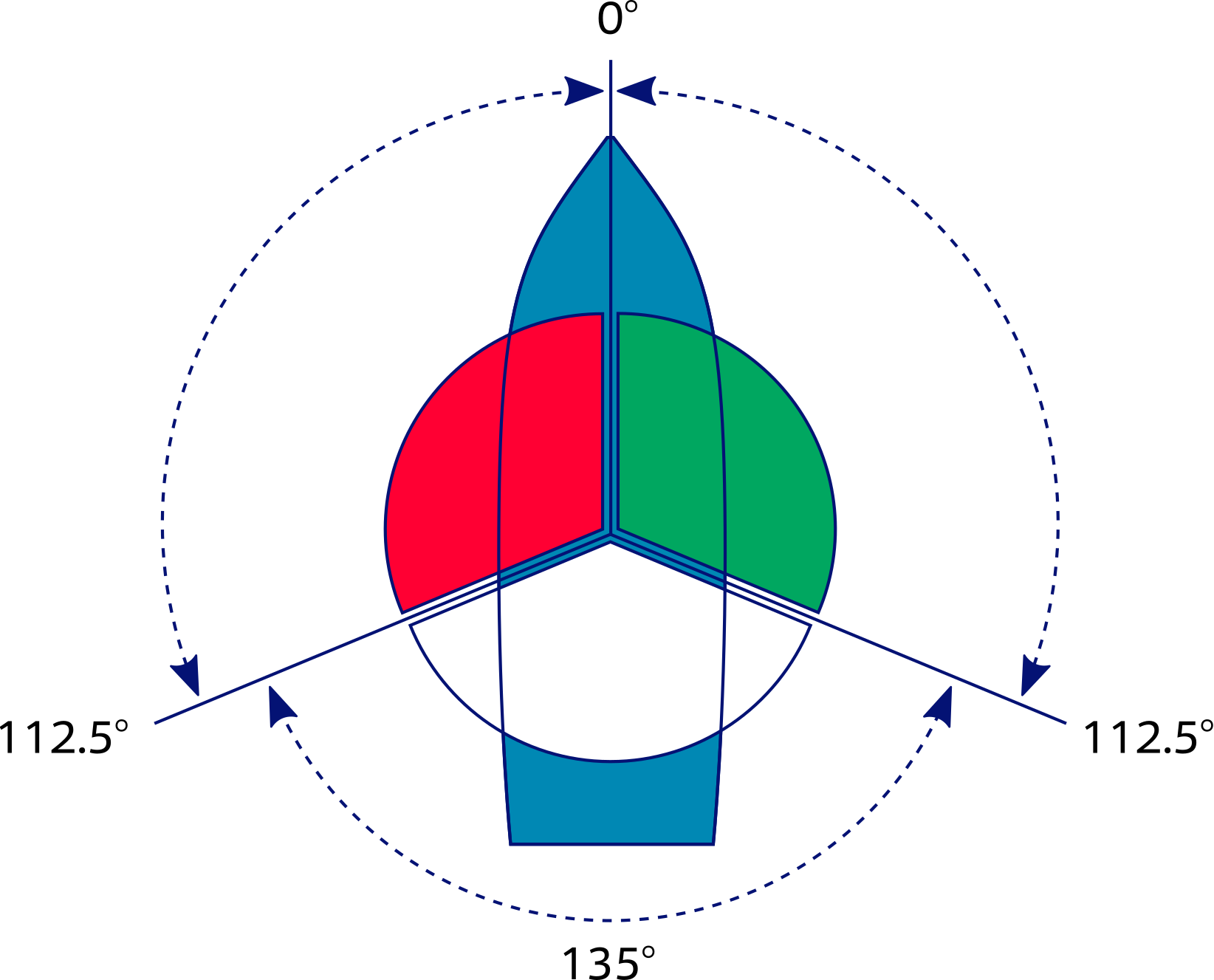
Definitions
- Masthead light
means a white light placed over the fore and aft centreline of the vessel showing an unbroken light over an arc of the horizon of 225° and so fixed as to show the light from right ahead to 22.5° abaft the beam on either side of the vessel. - Sidelight
means a green light on the starboard side and a red light on the port side each showing an unbroken light over an arc of the horizon of 112.5° and so fixed as to show the light from right ahead to 22.5° abaft the beam on its respective side.
In a vessel of less than 20 metres in length the sidelights may be combined in one lantern carried on the fore and aft centreline of the vessel. - Sternlight
means a white light placed as nearly as practicable at the stern showing an unbroken light over an arc of the horizon of 135° and so fixed as to show the light 67.5° from right aft on each side of the vessel. - Towing light
means a yellow light having the same characteristics as the sternlight. - All-round light
means a light showing an unbroken light over an arc of the horizon of 360°. - Flashing light
means a light flashing at regular intervals at a frequency of 120 flashes or more per minute.
Colour legend
![]() White light
White light
![]() Yellow light
Yellow light
![]() Green light
Green light
![]() Red light
Red light
![]() Yellow flashing light
Yellow flashing light
![]() Optional white light
Optional white light
Power-driven vessel underway
A power-driven vessel underway shall exhibit:
- a masthead light forward;
- a second masthead light abaft of and higher than the forward one; except that a vessel of less than 50 metres in length shall not be obliged to exhibit such light but may do so;
- sidelights;
- a sternlight.
| Power driven vessel underway, longer than 50 m | ||

|
||
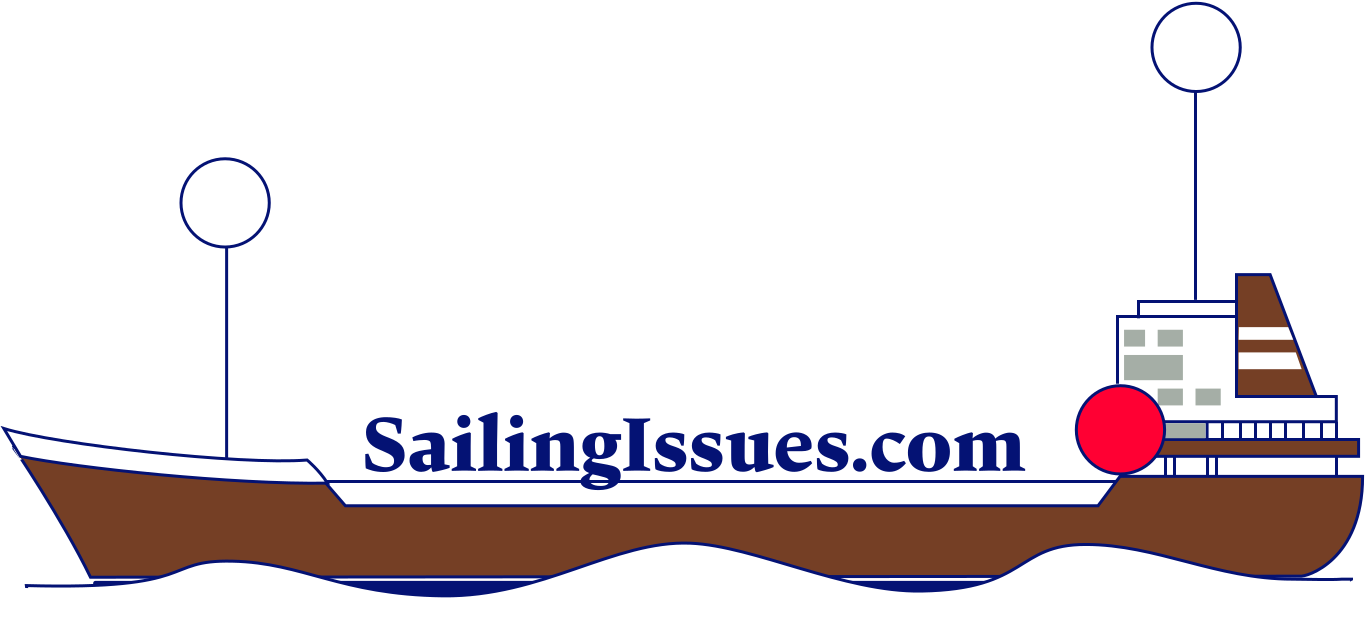
|
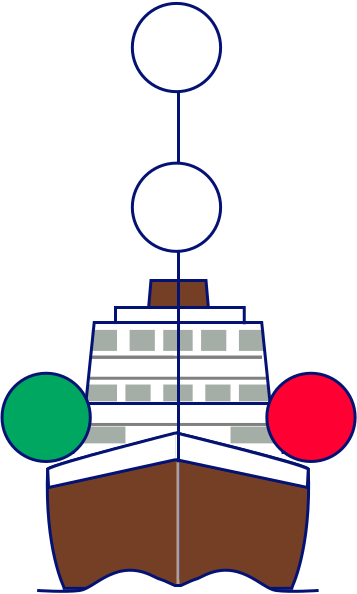
|
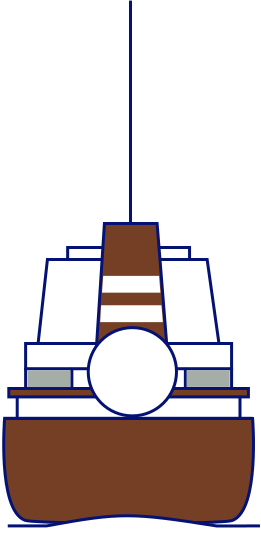
|
| Abeam, port side | Ahead | Astern |
| Power driven vessel underway, shorter than 50 m | ||
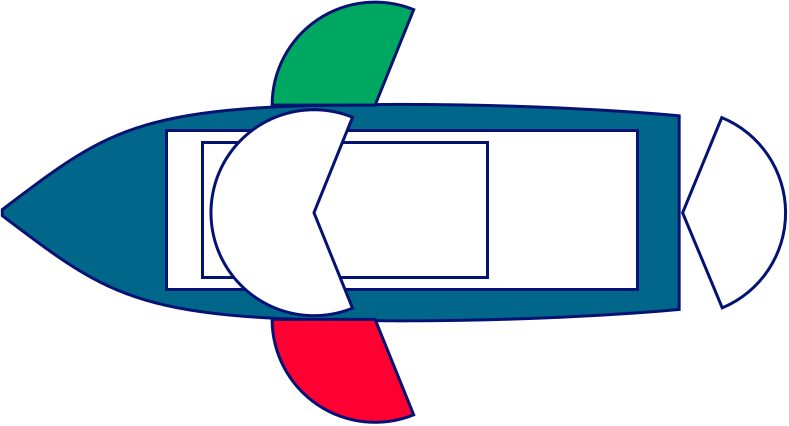
|
||
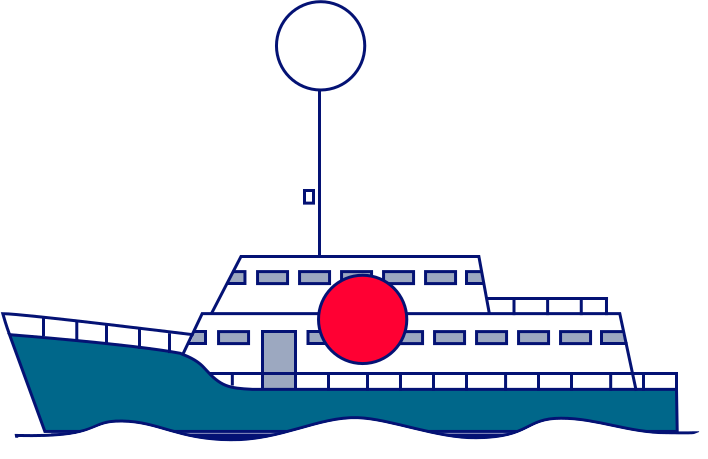
|
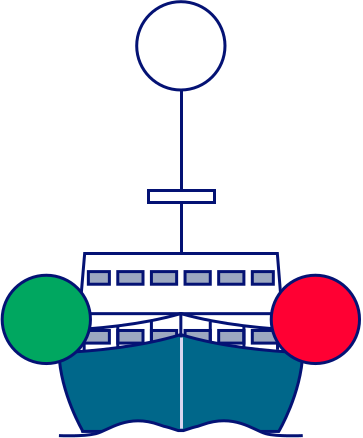
|
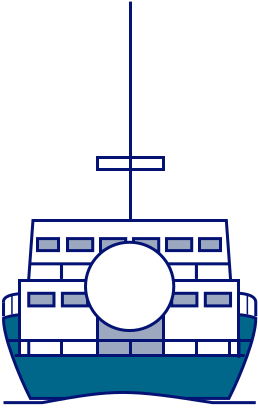
|
| Abeam, port side | Ahead | Astern |
She shall exibit lights according to a power-driven vessel.
Sailing vessels underway and vessels under oars
A sailing vessel underway shall exhibit:
- sidelights
- a sternlight
In a sailing vessel of less than 20 metres in length the lights may be combined in one lantern carried at or near the top of the mast where it can best be seen.
A sailing vessel underway may, in addition to the lights, exhibit at or near the top of the mast, where they can best be seen, two all-round lights in a vertical line, the upper being red and the lower green, but these lights shall not be exhibited in conjunction with the combined lantern.
4 lights configurations sailing
| Sailing vessel 1 | ||
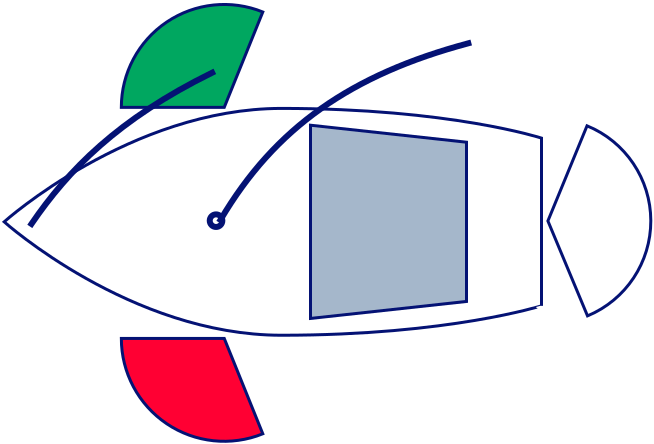
|
||
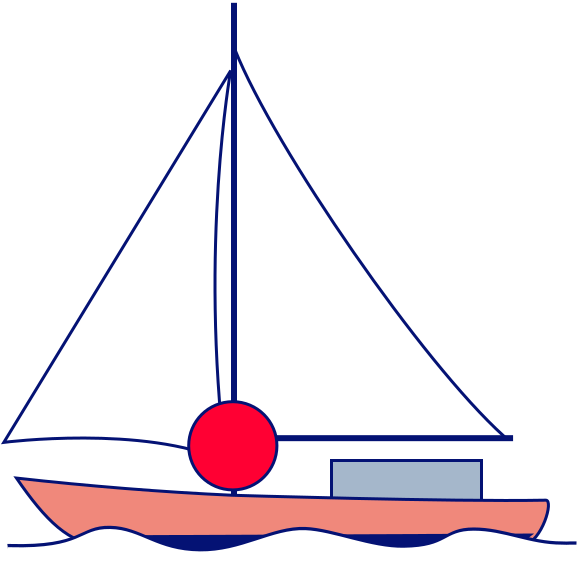
|
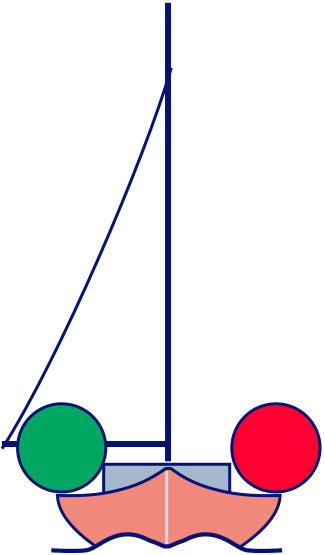
|
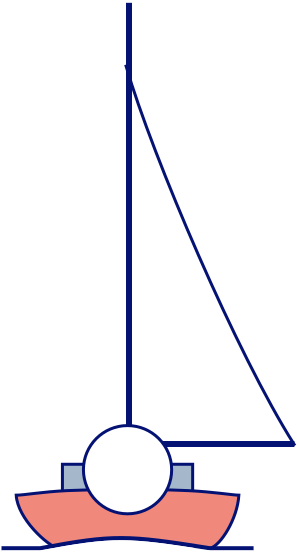
|
| Abeam, port side | Ahead | Astern |
| Sailing vessel 2 | ||
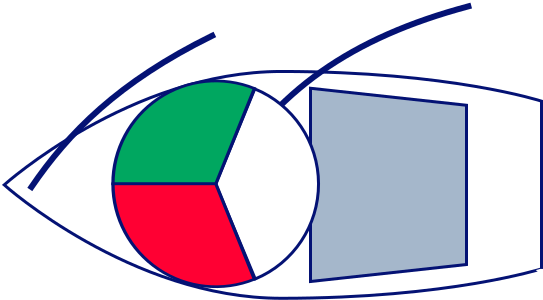
|
||
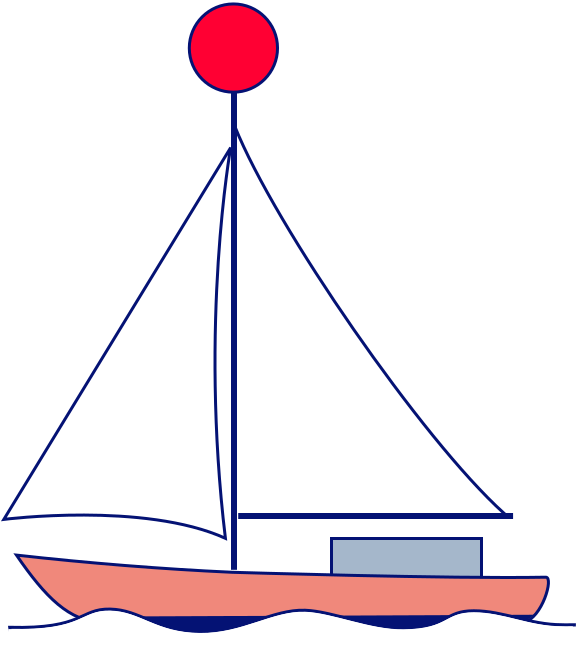
|
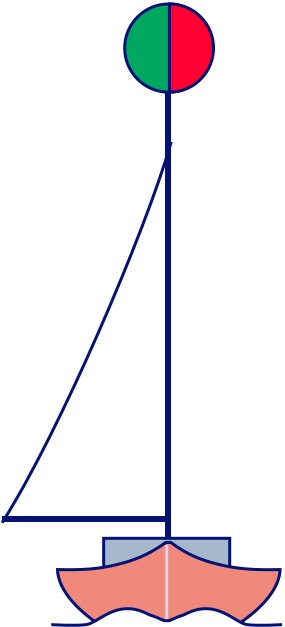
|
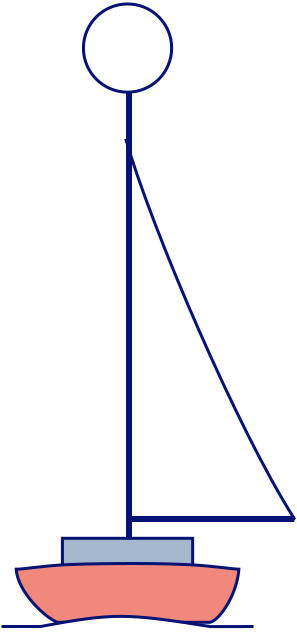
|
| Abeam, port side | Ahead | Astern |
| Sailing vessel 3 | ||
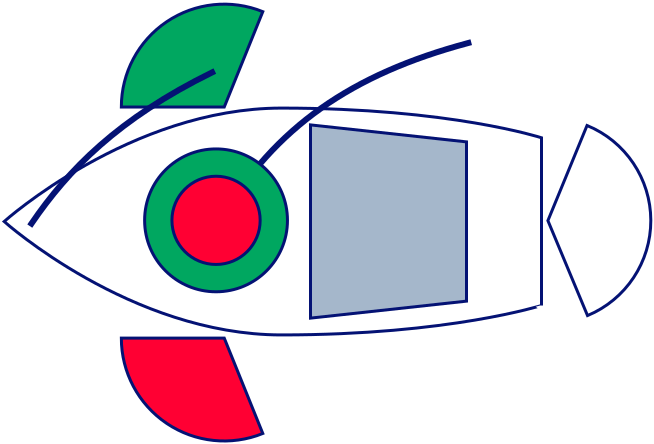
|
||
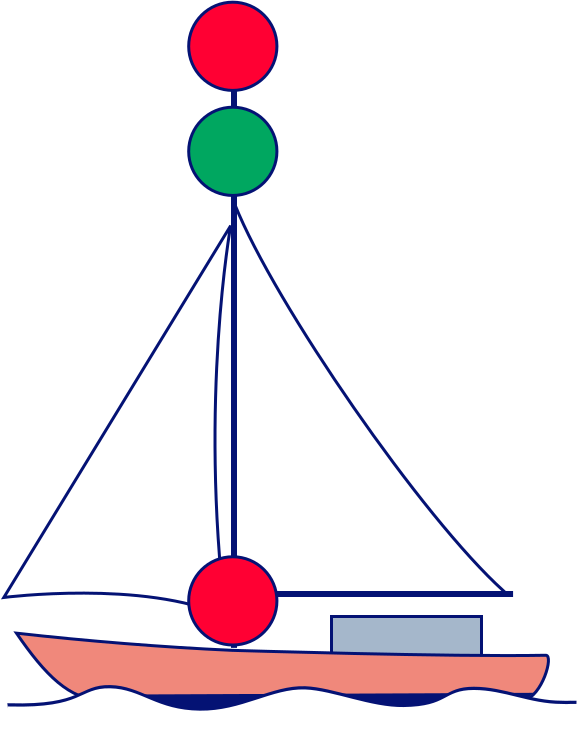
|
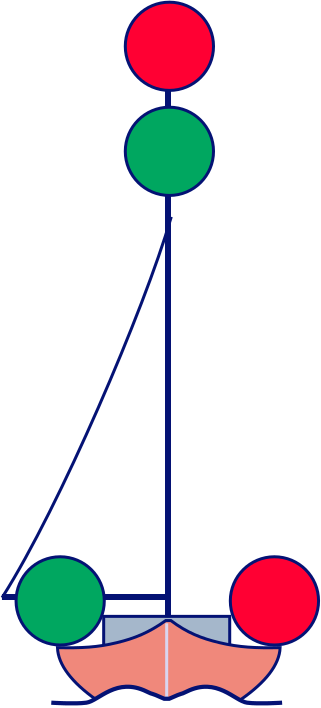
|
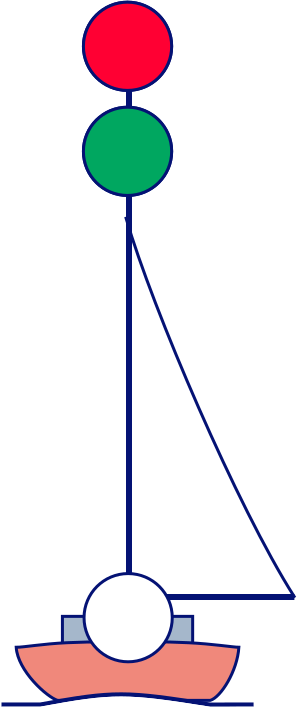
|
| Abeam, port side | Ahead | Astern |
| Sailing vessel 4 | ||
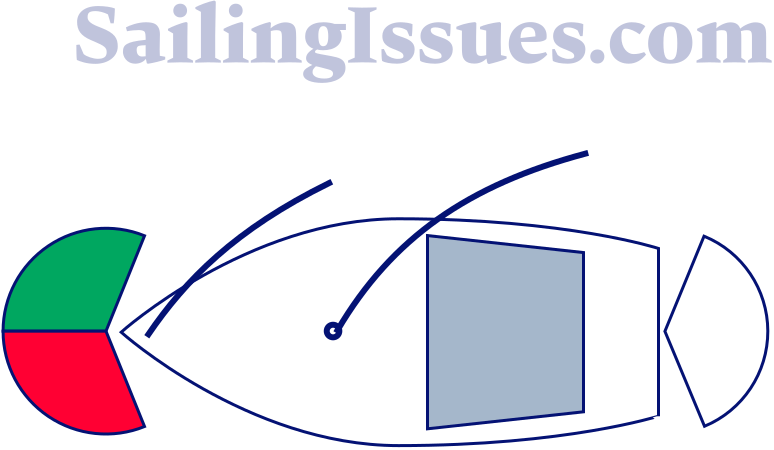
|
||
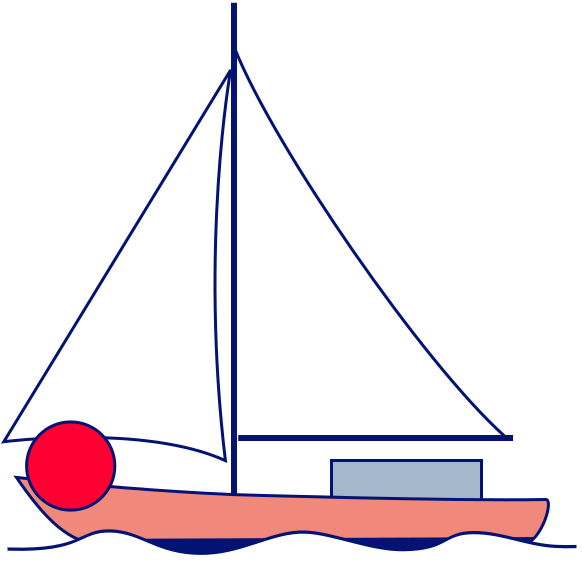
|
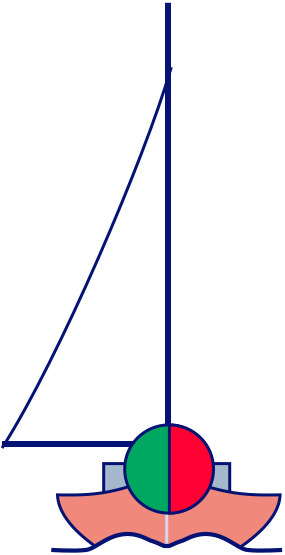
|
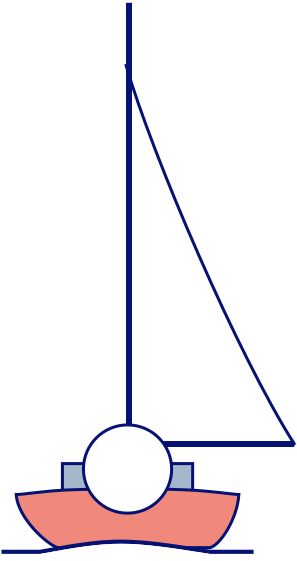
|
| Abeam, port side | Ahead | Astern |
A sailing vessel of less than 7 metres in length shall, if practicable, exhibit the lights prescribed above, but if she does not, she shall have ready at hand an electric torch or lighted lantern showing a white light which shall be exhibited in sufficient time to prevent collision.
A vessel under oars may exhibit the lights prescribed in this Rule for sailing vessels, but if she does not, she shall have ready at hand an electric torch or lighted lantern showing a white light which shall be exhibited in sufficient time to prevent collision.
Sailing and Motoring
A vessel proceeding under sail which has her engine running shall exhibit, forward where it can best be seen, a conical shape, apex downwards.
She shall exibit lights according to a power-driven vessel.
| Sailing and motoring | ||
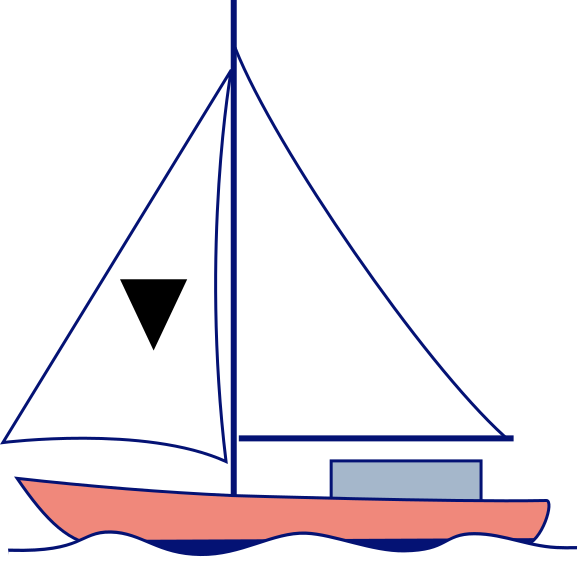
|
Day sign | |
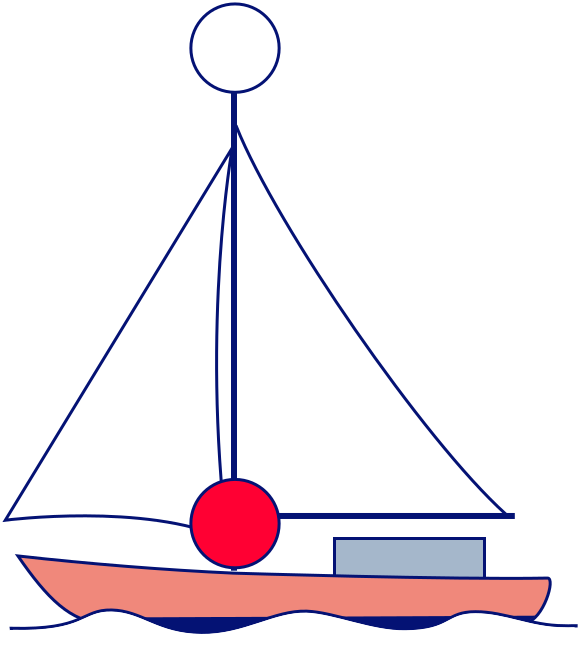
|
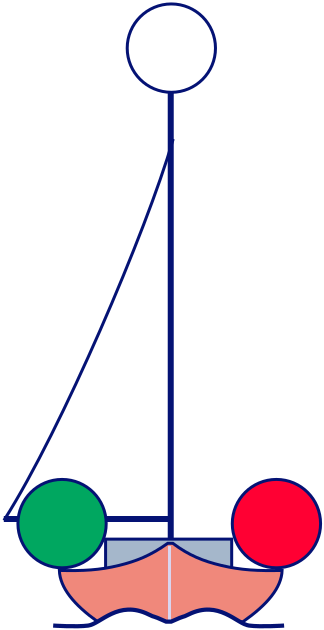
|
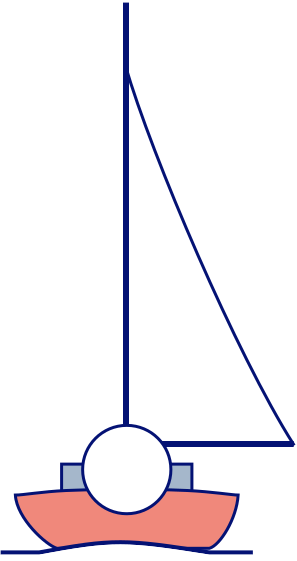
|
| Abeam, port side | Ahead | Astern |
Anchoring
A vessel at anchor shall according to Rule 30 (a) (b) exhibit where it can best be seen:
- in the fore part, an all-round white light or one ball;
- at or near the stern and at a lower level than the light prescribed in Rule 30(a)(i), an all-round white light.
| Anchored vessel, longer than 50 m | ||
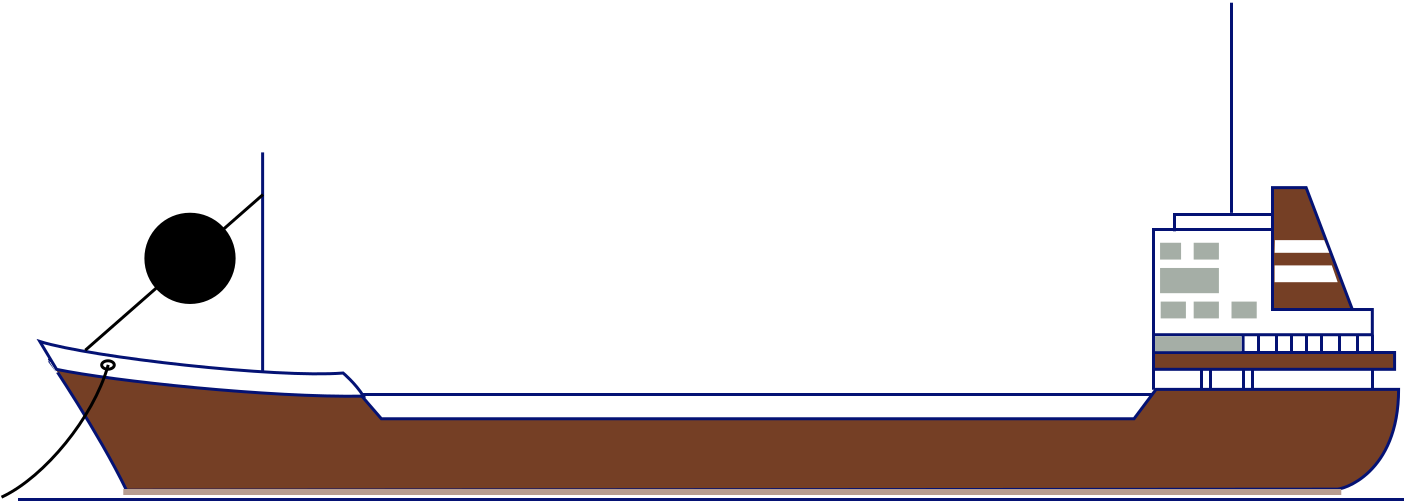
|
Day sign (1 black sphere) |
|
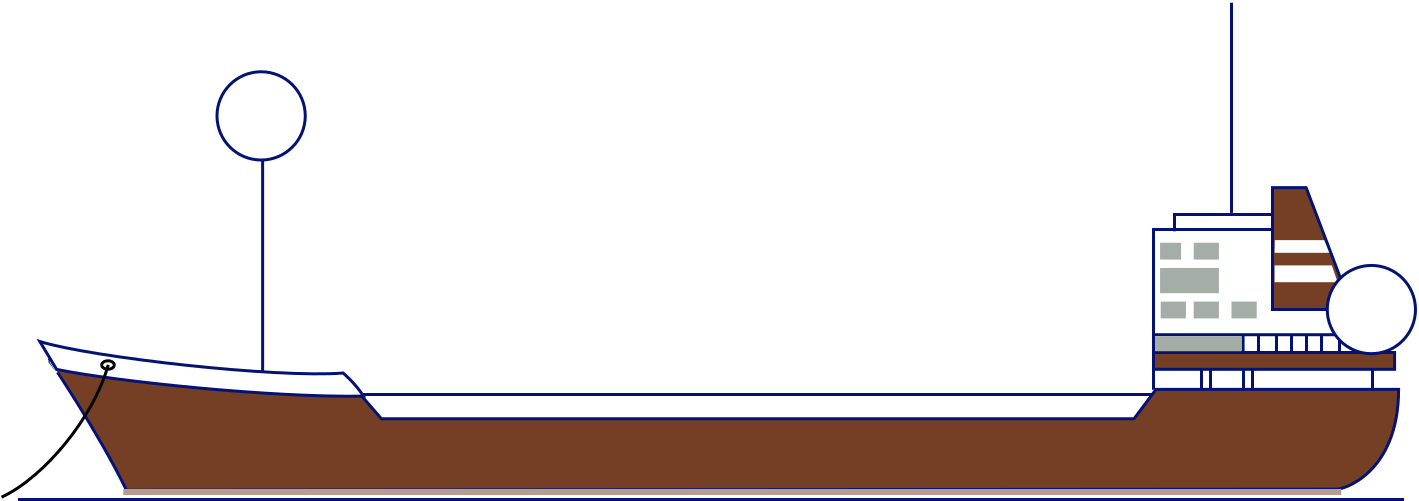
|
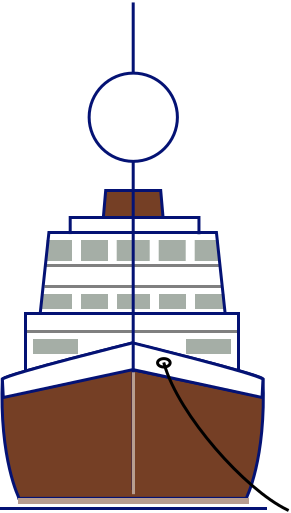
|
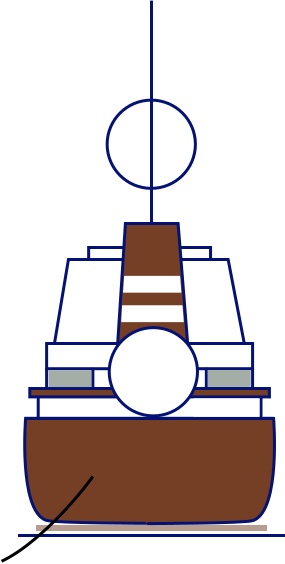
|
| Abeam, port side | Ahead | Astern |
| Anchored vessel, shorter than 50 m | ||
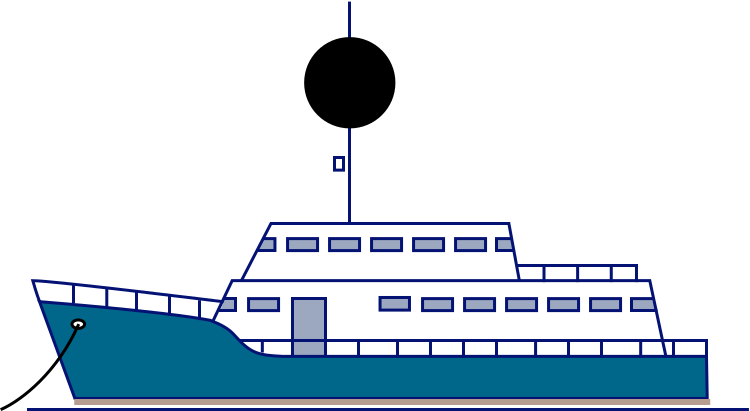
|
Day sign (1 black sphere) |
|
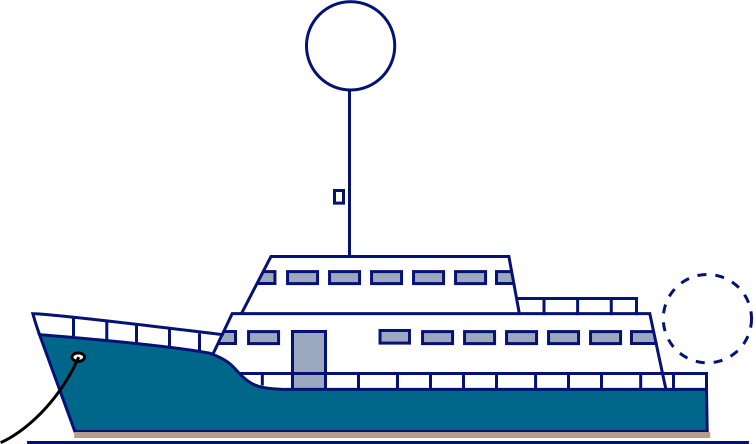
|
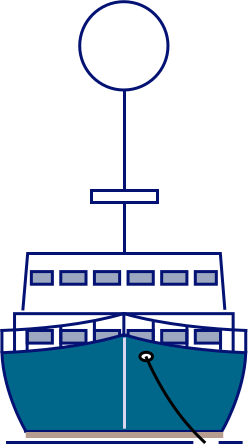
|
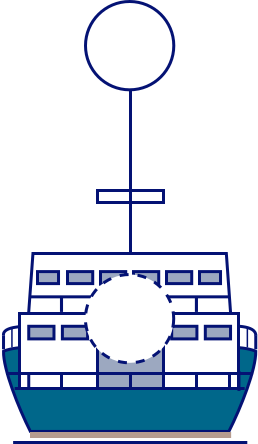
|
| Abeam, port side | Ahead | Astern |
| Anchored sailing boat | ||
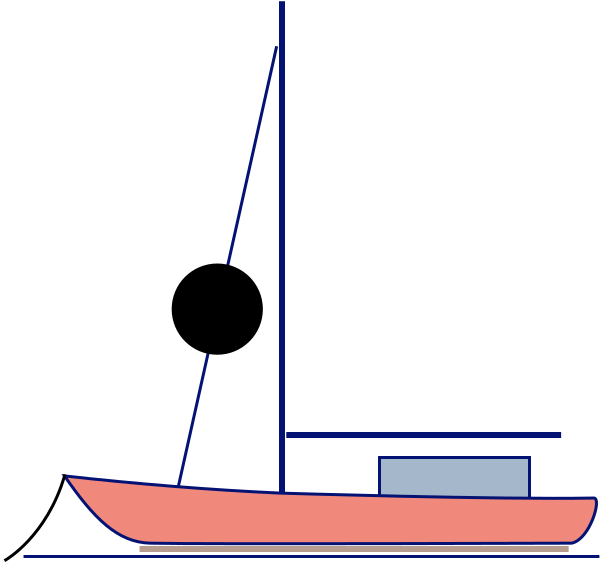
|
Day sign (1 black sphere) |
|
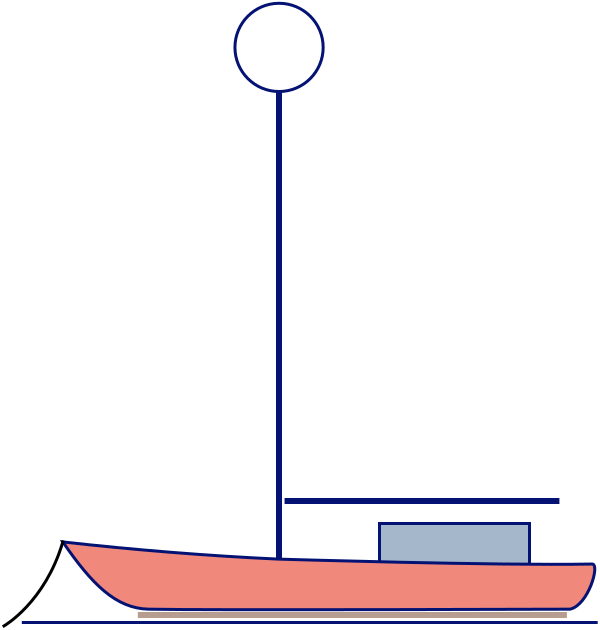
|
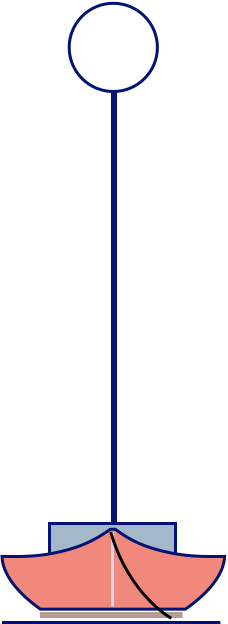
|
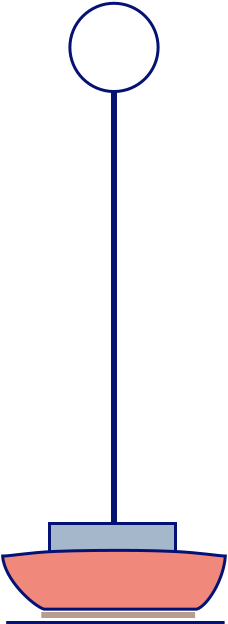
|
| Abeam, port side | Ahead | Astern |
Aground
A vessel aground shall according to Rule 30 (d) exhibit the lights prescribed in Rule 30(a) or (b) and in addition, if practicable, where they can best be seen;
- two all-round red lights in a vertical line;
- three balls in a vertical line.
| Aground, longer than 50 m | ||
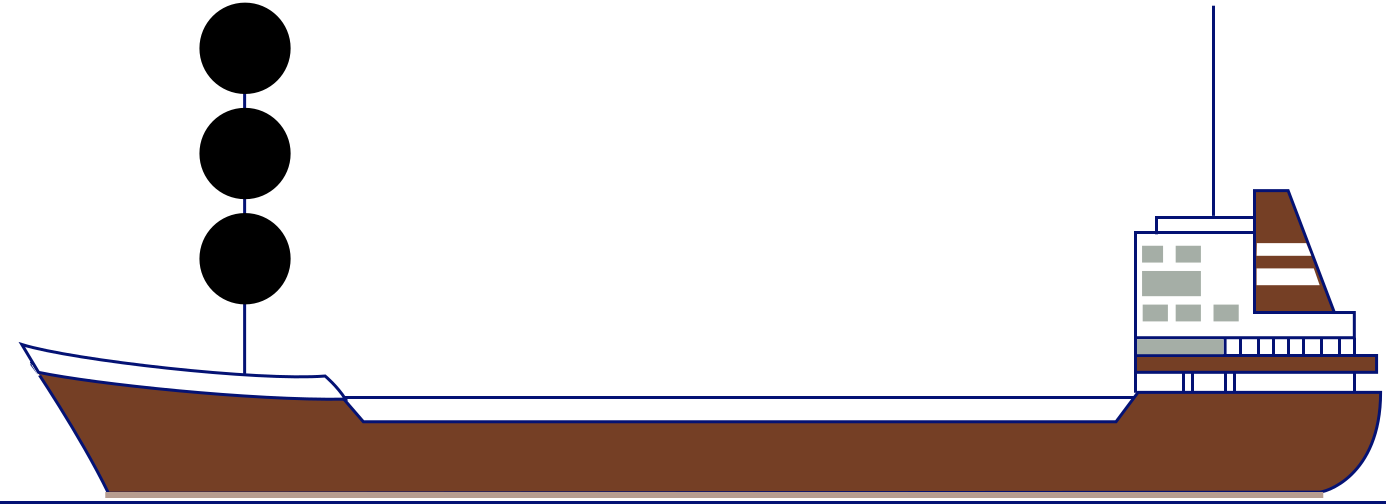
|
Day sign (3 black spheres) |
|
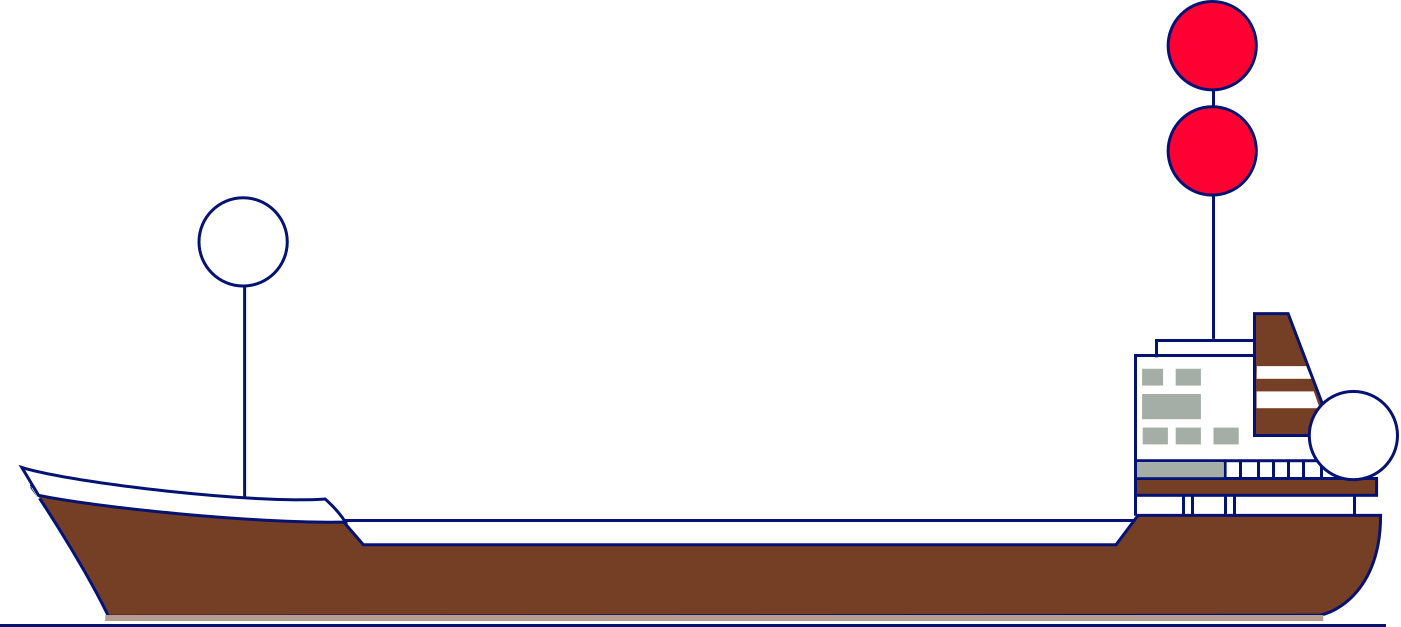
|
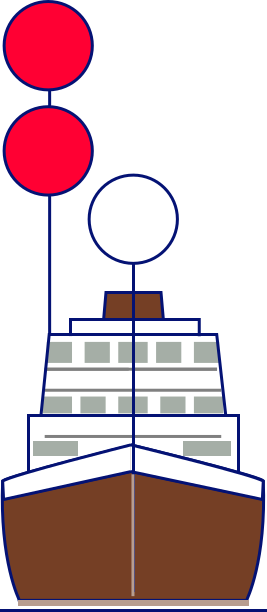
|
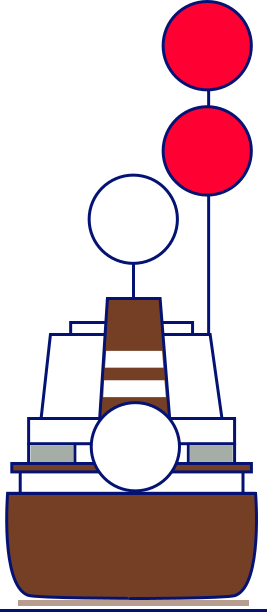
|
| Abeam, port side | Ahead | Astern |
Towing
A power-driven vessel when towing shall exhibit:
- two masthead lights in a vertical line. When the length of the tow, measuring from the stern of the towing vessel to the after end of the tow exceeds 200 metres, three such lights in a vertical line; Rule 24;
- sidelights;
- a sternlight;
- a towing light in a vertical line above the sternlight;
- when the length of the tow exceeds 200 metres, a diamond shape where it can best be seen.
| Tugboat longer than 50 m – tow longer than 200 m | ||

|
||
| Abeam, port side | ||
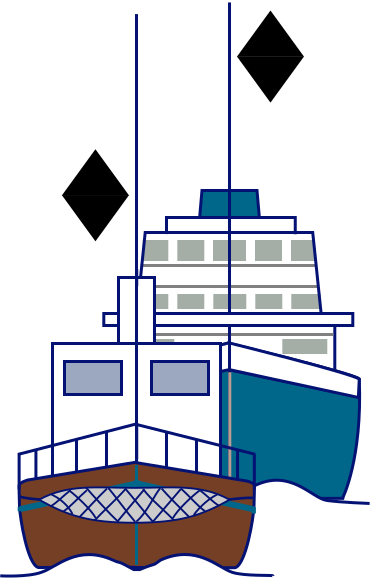
|
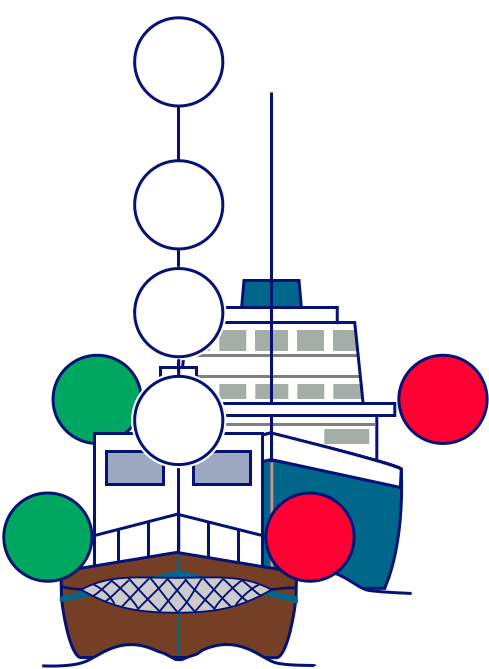
|
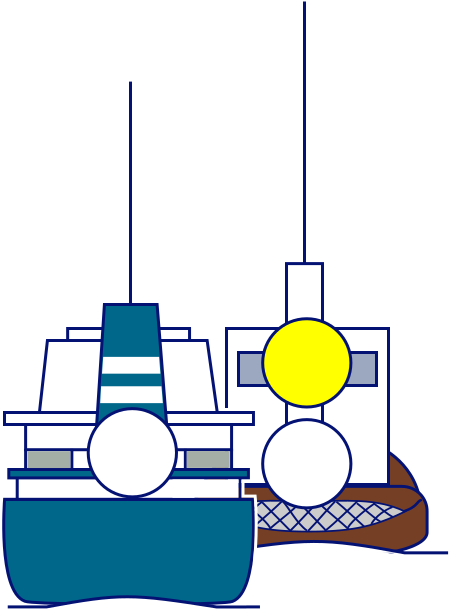
|
| Ahead, Day sign (diamond shapes) |
Ahead | Astern |
| Tugboat shorter than 50 m – tow longer than 200 m | ||

|
||
| Abeam, port side | ||
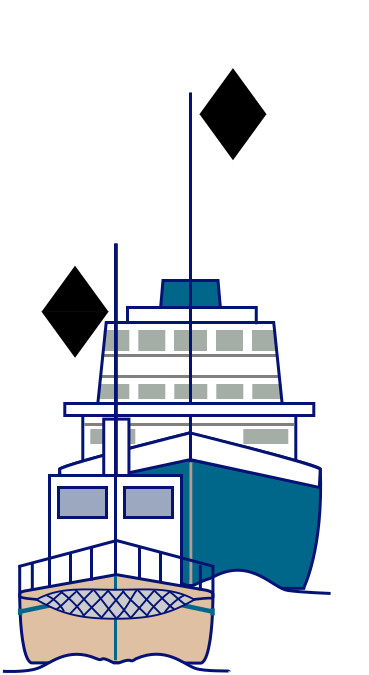
|
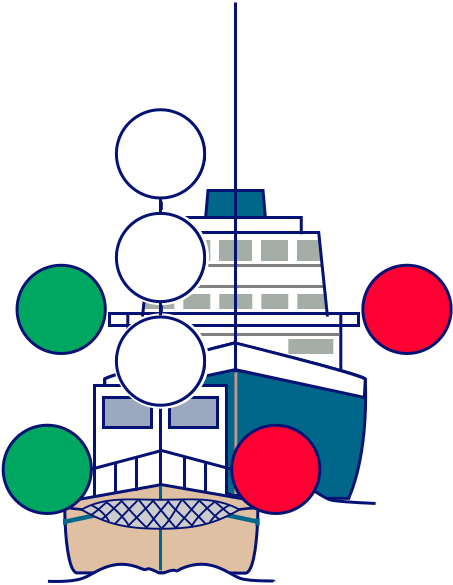
|
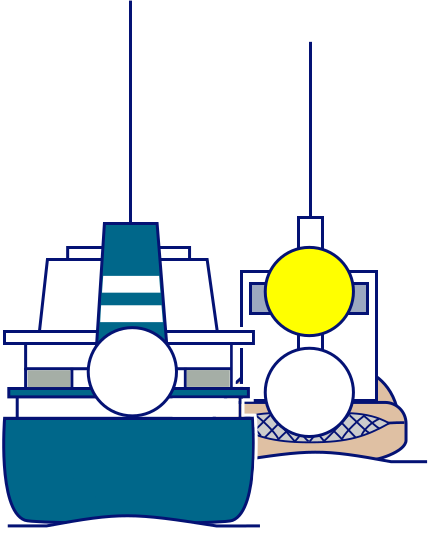
|
| Ahead, Day sign (diamond shapes) |
Ahead | Astern |
| Tugboat longer than 50 m – tow shorter than 200 m | ||
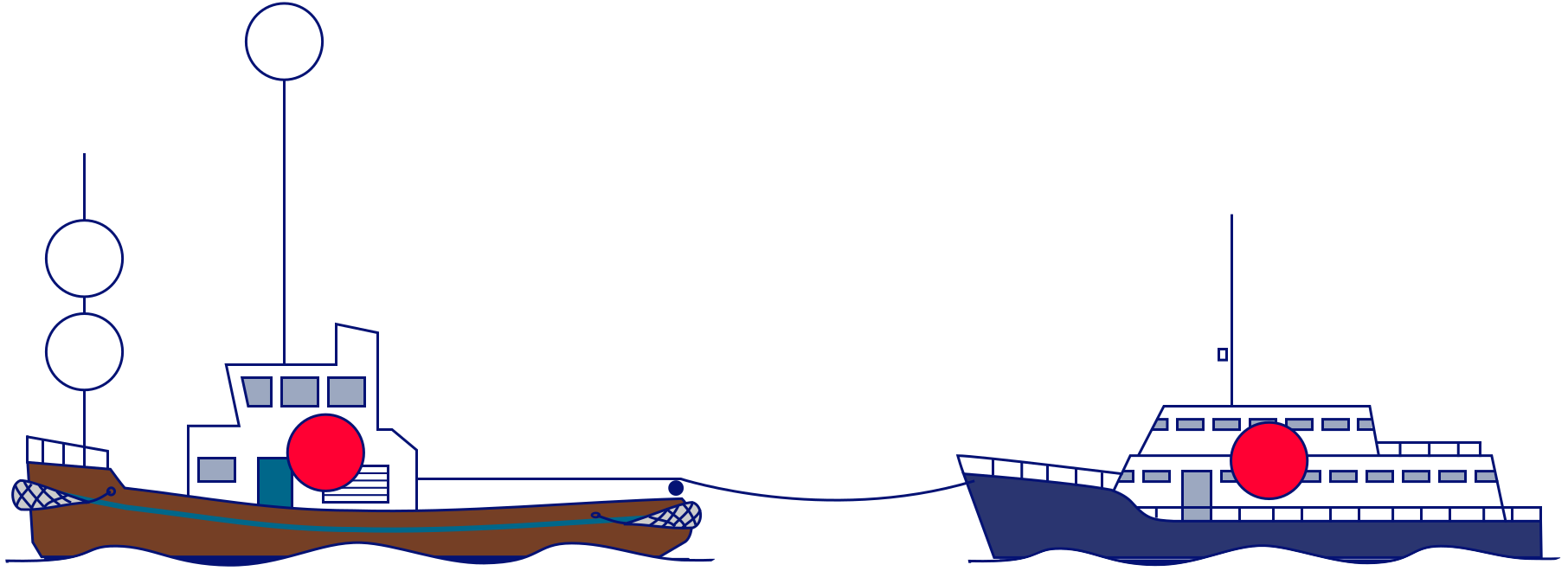
|
Abeam, port side |
|
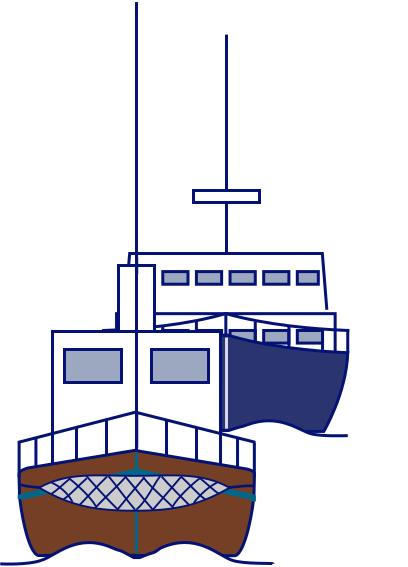
|
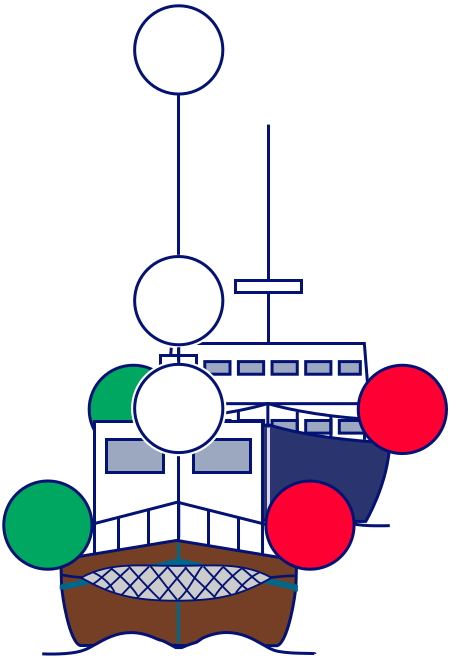
|
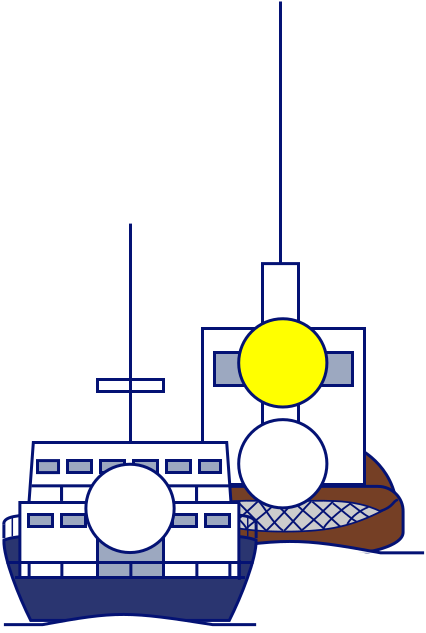
|
| Ahead, Day sign (no shapes) |
Ahead | Astern |
| Tugboat shorter than 50 m – tow shorter than 200 m | ||

|
Abeam, port side |
|
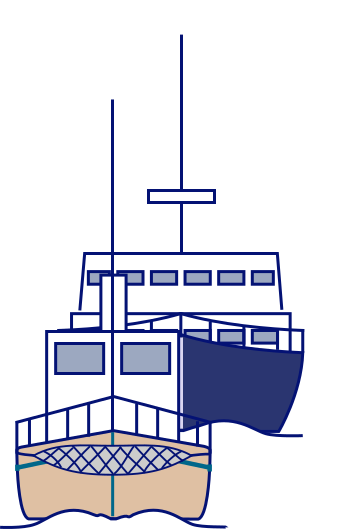
|
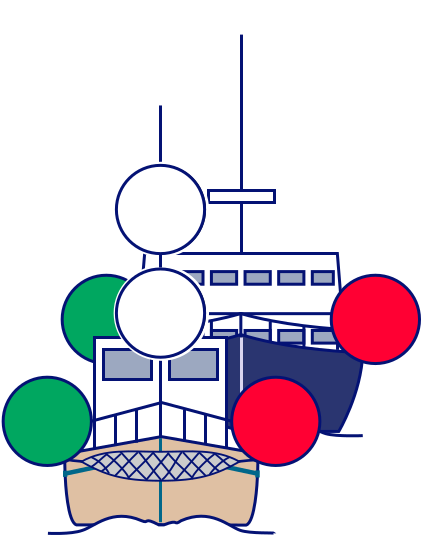
|
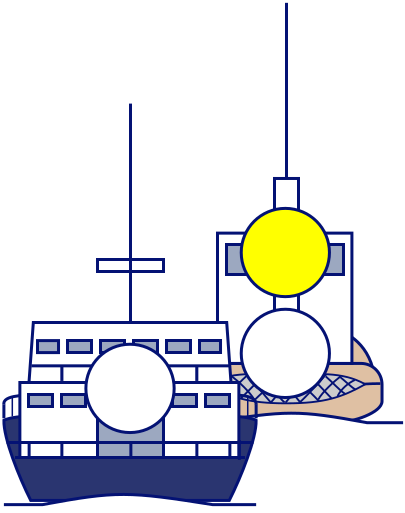
|
| Ahead, Day sign (no shapes) |
Ahead | Astern |
Note that tugboats longer than 50 m are uncommon.
towing vessel less than 50 m in length;
length of tow exceeds 200 m.
towing vessel less than 50 m in length;
length of tow 200 m or less.
Towing an inconspicuous, partly submerged object
An inconspicuous, partly submerged vessel or object, or combination of such vessels or objects being towed; Rule 24 (g), shall exhibit:
- if it is less than 25 metres in breadth, one all-round white light at or near the forward end and one at or near the after end except that dracones need not exhibit a light at or near the forward end;
- if it is 25 metres or more in breadth, two additional all-round white lights at or near the extremities of its breadth;
- if it exceeds 100 metres in length, additional all-round white lights between these lights so that the distance between the lights shall not exceed 100 metres;
- a diamond shape at or near the aftermost extremity of the last vessel or object being towed and if the length of the tow exceeds 200 metres an additional diamond shape where it can best be seen and located as far forward as is practicable.
| Tow shorter than 200 m, object shorter than 100 m | ||

|
||
| Abeam, port side | ||
| Tow longer than 200 m, object shorter than 100 m | ||

|
||
| Abeam, port side | ||
| Tow longer than 200 m, object longer than 100 m | ||

|
||
| Abeam, port side | ||
| Tow longer than 200 m, object wider than 25 m | ||

|
||
| Abeam, port side (note that often a fifth round white light in the center is added) | ||
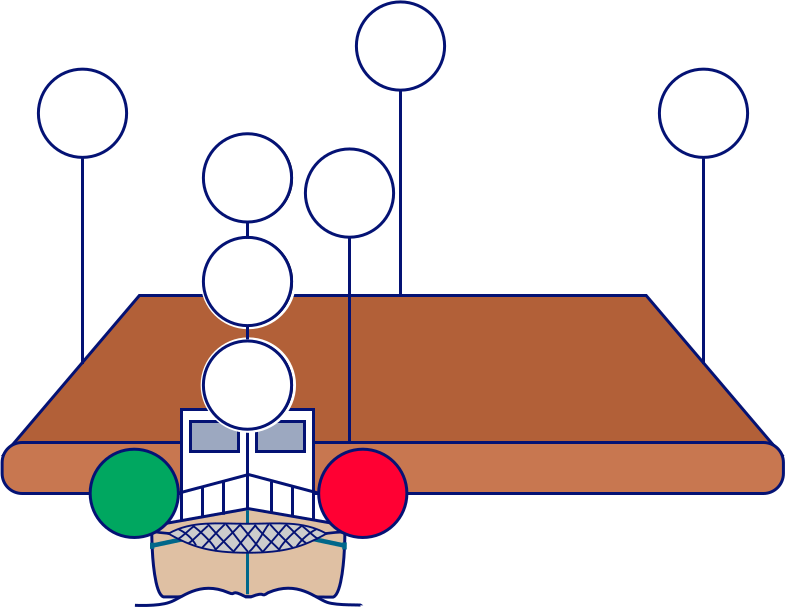
|
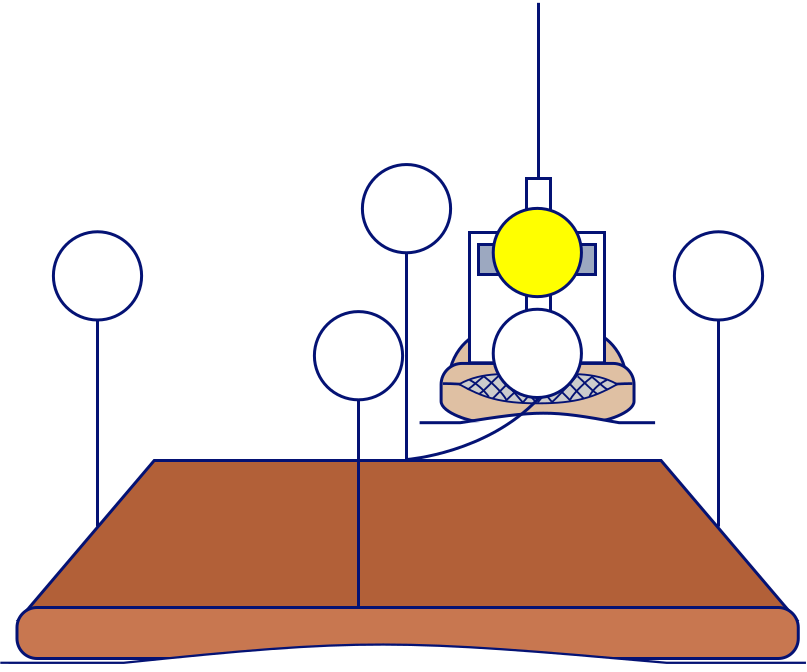
|
|
| Ahead | Astern | |
| Tow longer than 200 m, any object size | ||

|
||
| Day sign, Abeam, port side | ||
Pushing from ahead or towing alongside
When a pushing vessel and a vessel being pushed ahead are rigidly connected in a composite unit they shall be regarded as a power-driven vessel and exhibit the normal lights.
A power-driven vessel when pushing ahead or towing alongside, except in the case of a composite unit; Rule 24 (c), shall exhibit:
- two masthead lights in a vertical line;
- sidelights;
- a sternlight.
A vessel or object being towed shall exhibit:
- sidelights;
- a sternlight;
- when the length of the tow exceeds 200 metres, a diamond shape where it can best be seen.
- Provided that any number of vessels being towed alongside or pushed in a group shall be lighted as one vessel,
- a vessel being pushed ahead, not being part of a composite unit, shall exhibit at the forward end, sidelights;
- a vessel being towed alongside shall exhibit a sternlight and at the forward end, sidelights.
| Pushing from ahead | |

|
|
| Abeam, port side | |
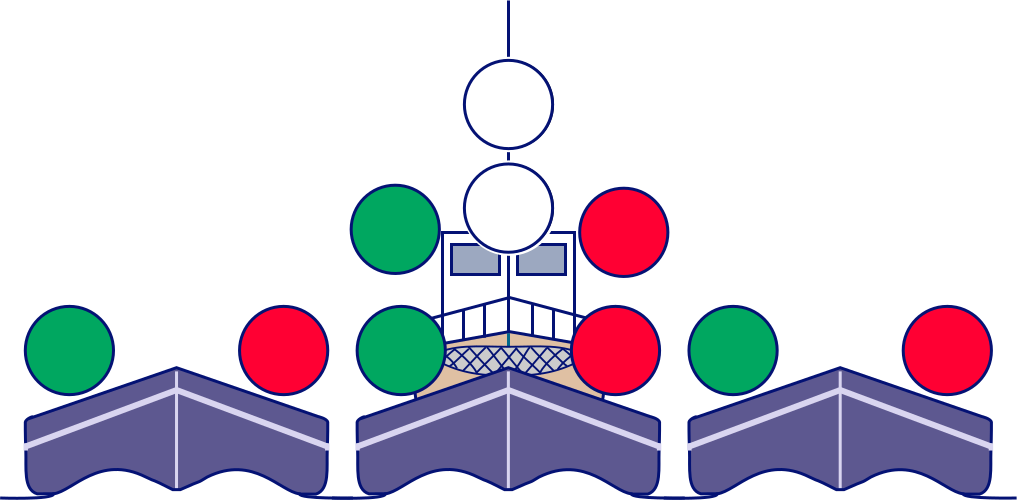
|
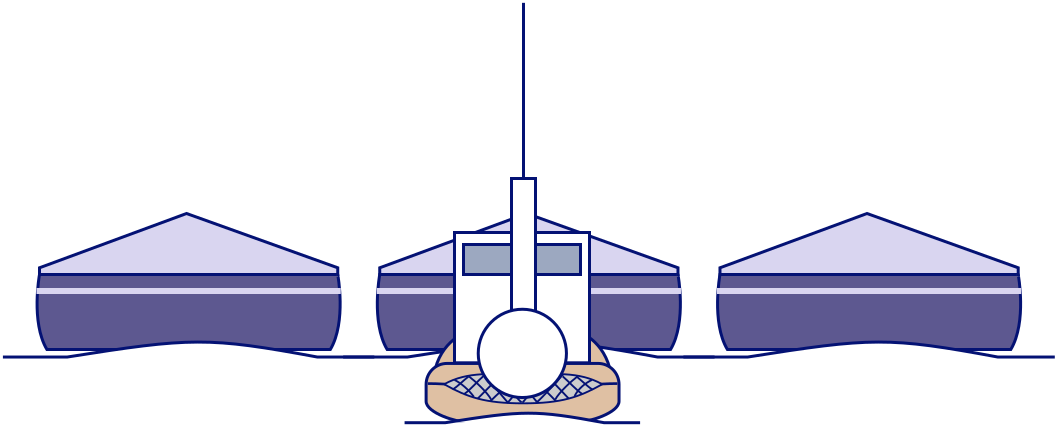
|
| Ahead | Astern |
| Towing alongside | |
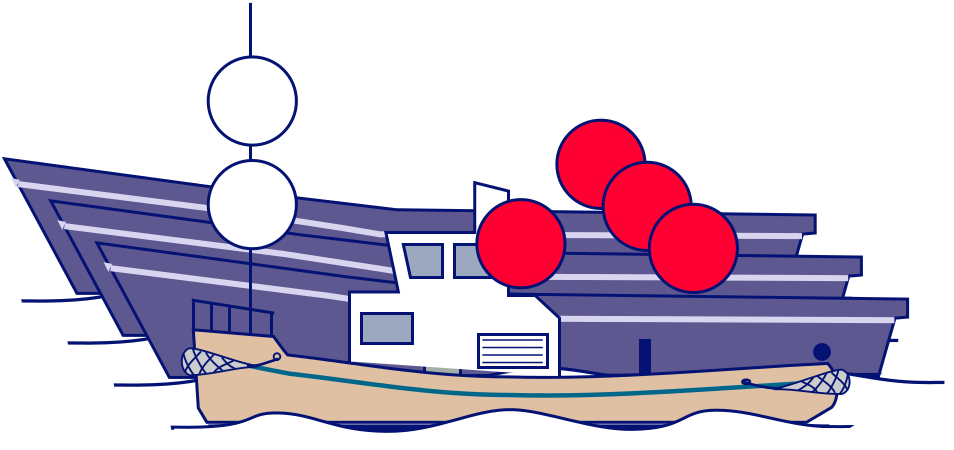
|
Abeam, port side |
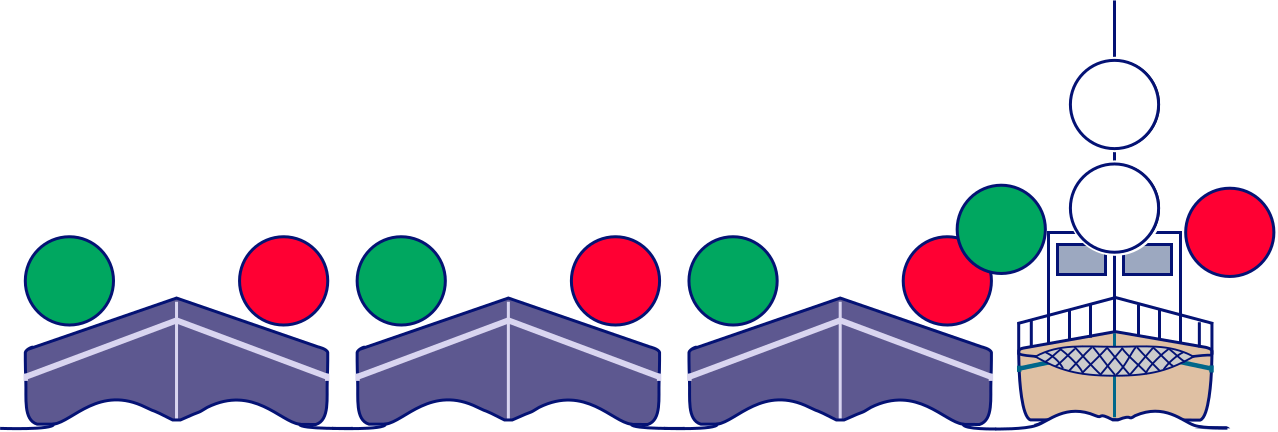
|
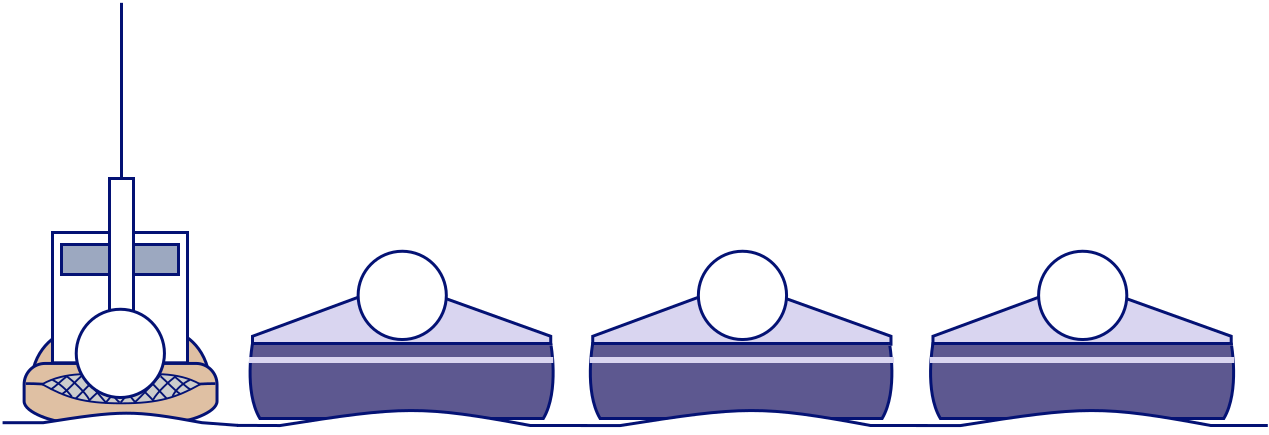
|
| Ahead | Astern |
Fishing – Trawling
A vessel engaged in fishing, whether underway or at anchor, shall exhibit only the lights and shapes prescribed below; Rule 26
A vessel when engaged in trawling, by which is meant the dragging through the water of a dredge net or other apparatus used as a fishing appliance, shall exhibit:
- two all-round lights in a vertical line, the upper being green and the lower white, or a shape consisting of two cones with their apexes together in a vertical line one above the other;
- a masthead light abaft of and higher than the all-round green light; a vessel of less than 50 metres in length shall not be obliged to exhibit such a light but may do so;
- when making way through the water, in addition to the lights prescribed hereh, sidelights and a sternlight.
- when shooting nets, white light over white light (Flag Z by day);
- when hauling nets, white light over red light (Flag G by day);
- When nets are caught on the bottom, red light over red light (Flag P by day).
| Fishing vessel, trawling | ||
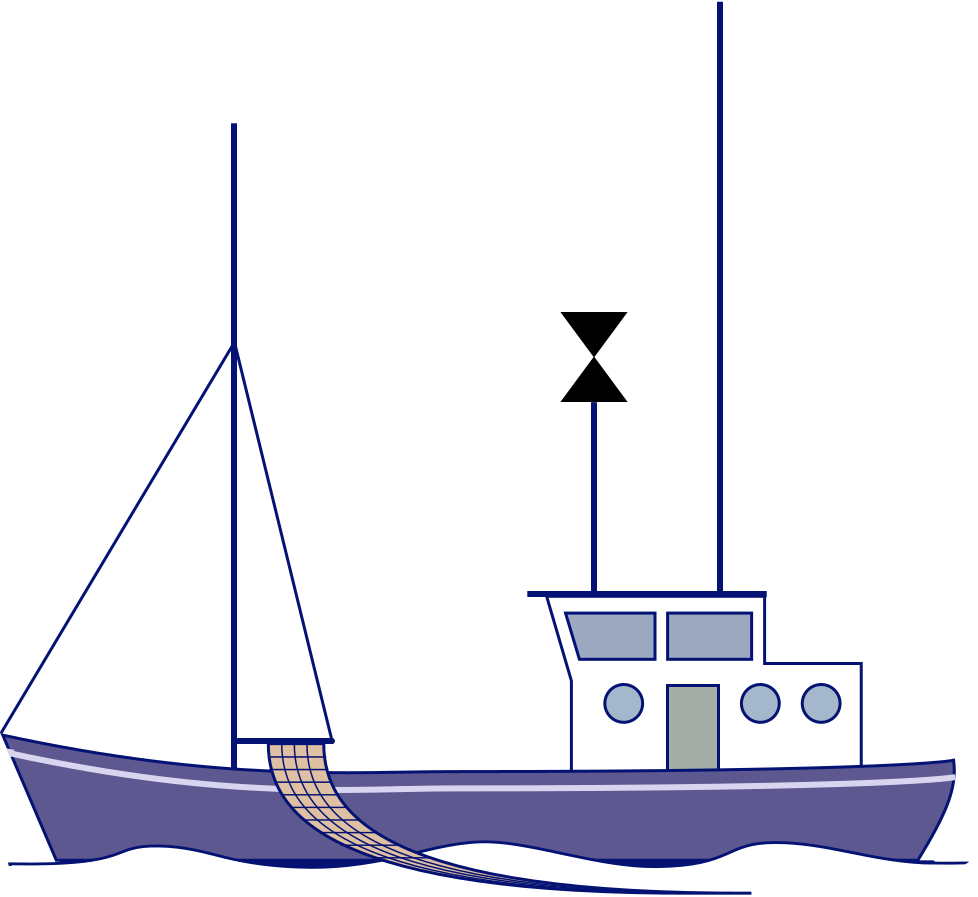
|
Day sign | |
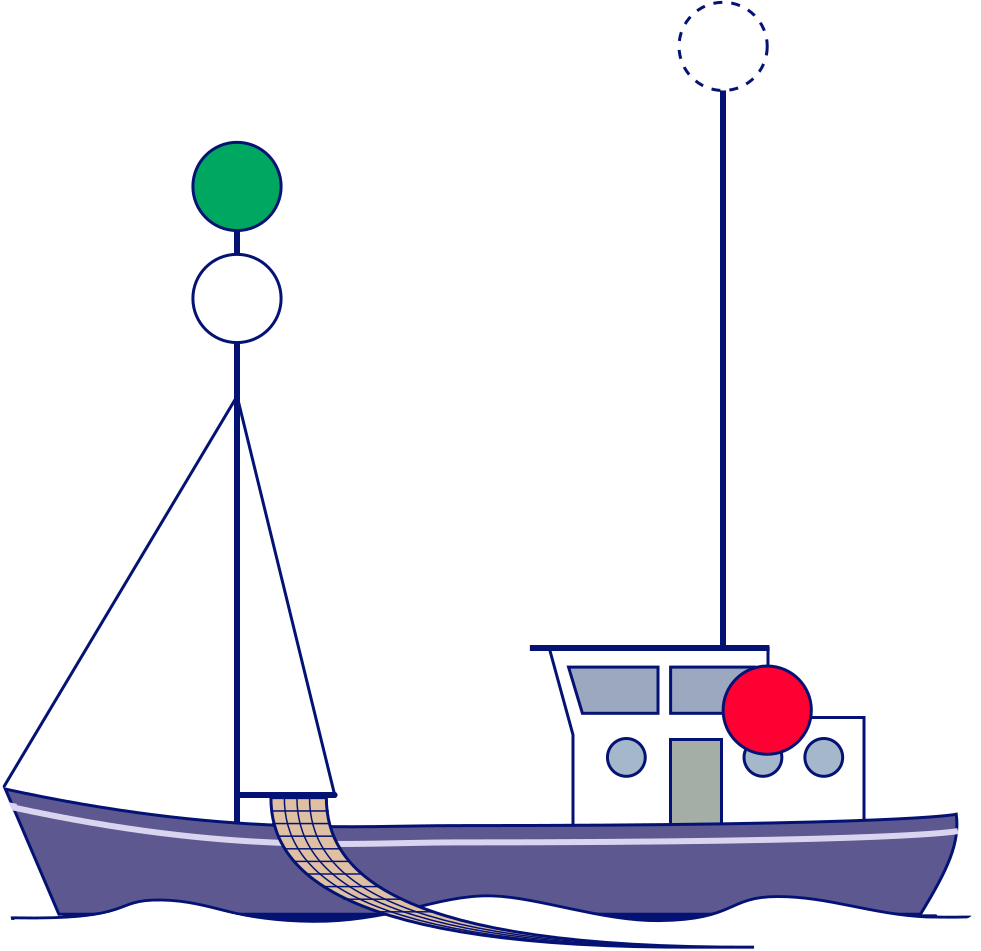
|
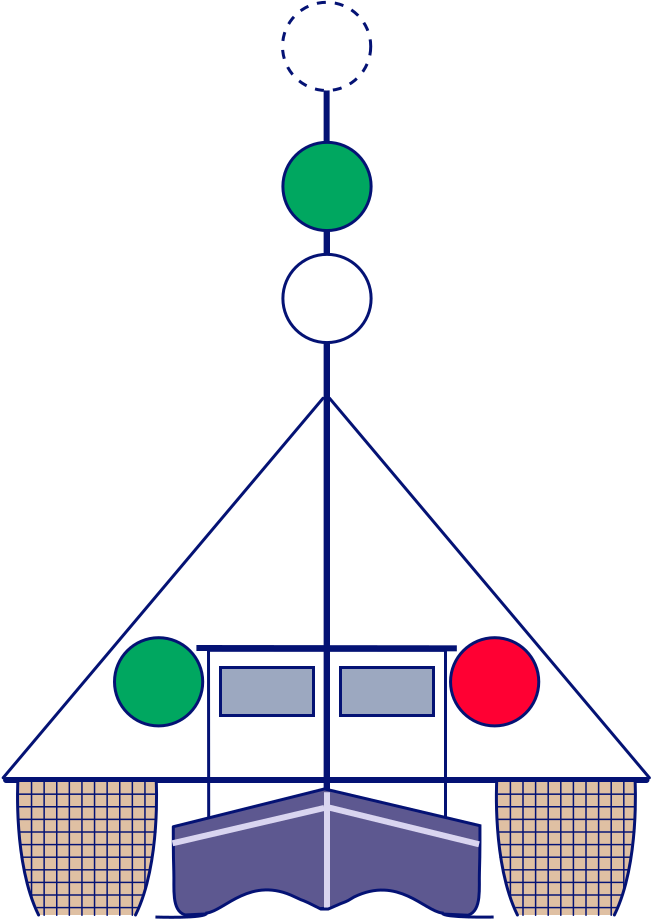
|
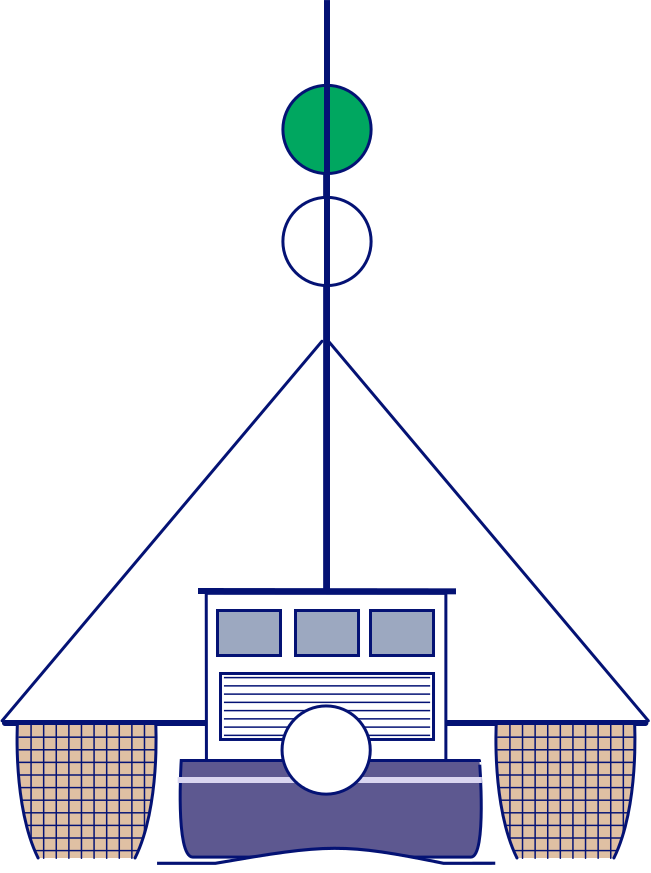
|
| Abeam, port side |
Ahead |
Astern |
| Fishing vessel, trawling, shooting nets (white over white) | ||
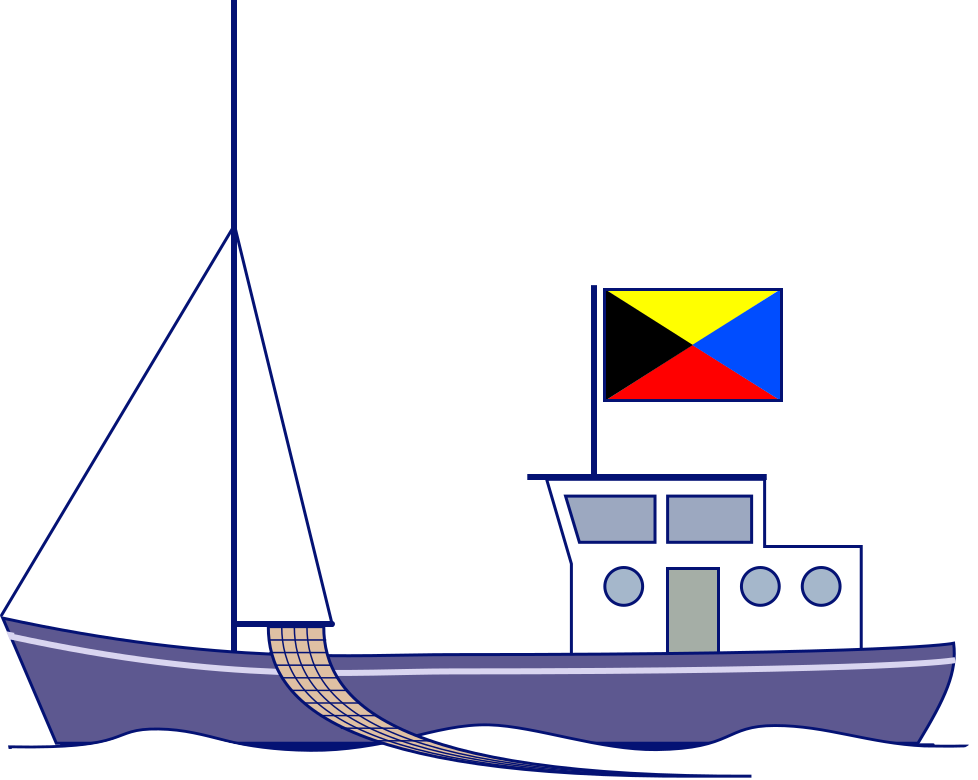
|
Day sign • Flag Z | |
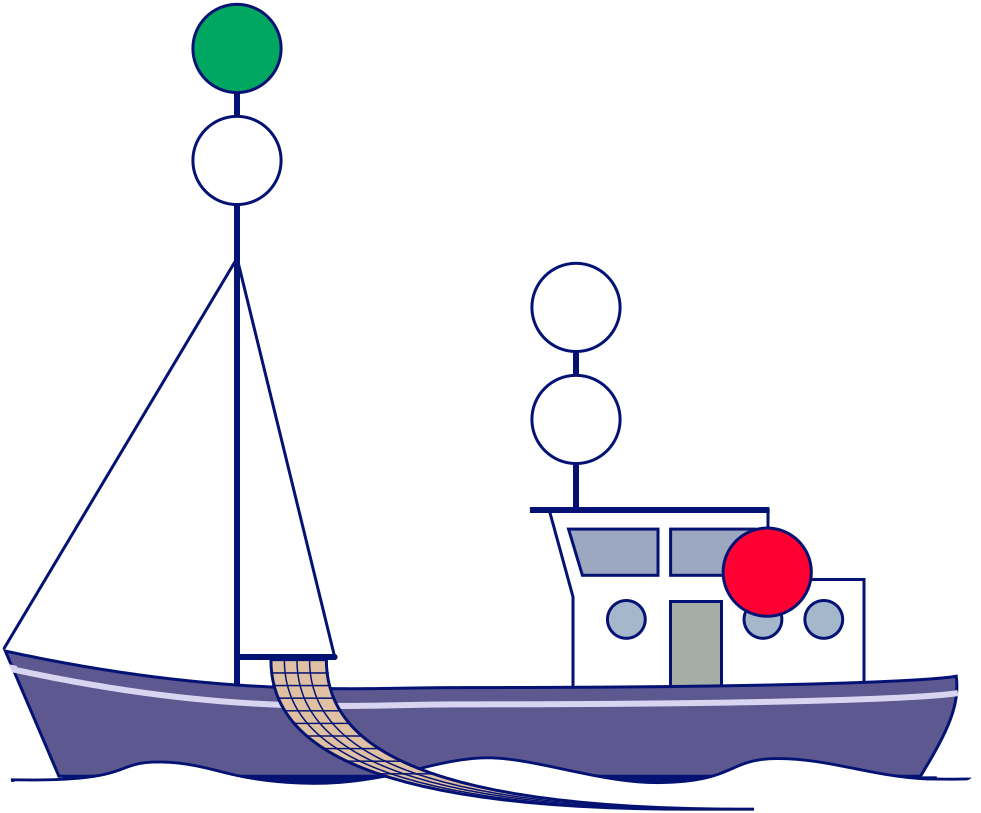
|
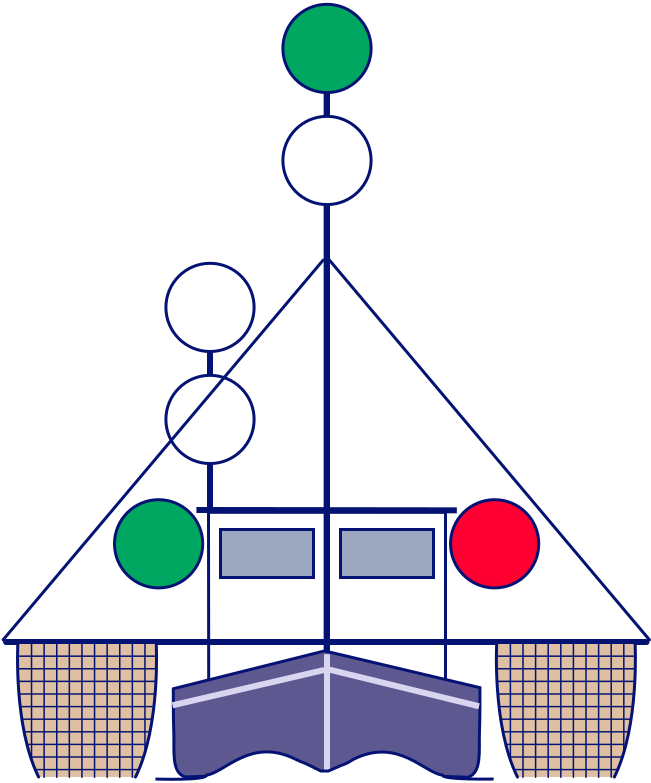
|
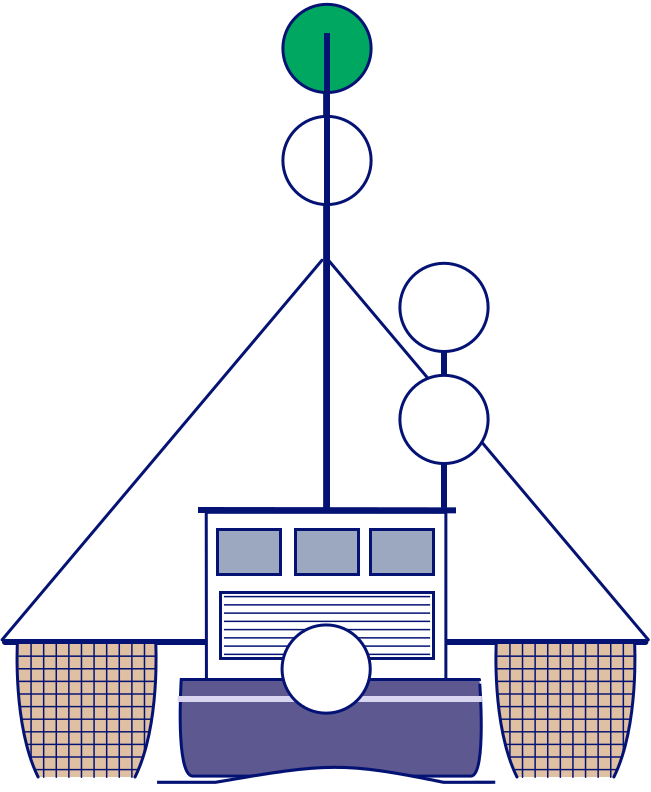
|
| Abeam, port side | Ahead | Astern |
| Fishing vessel, trawling, hauling nets (white over red) | ||
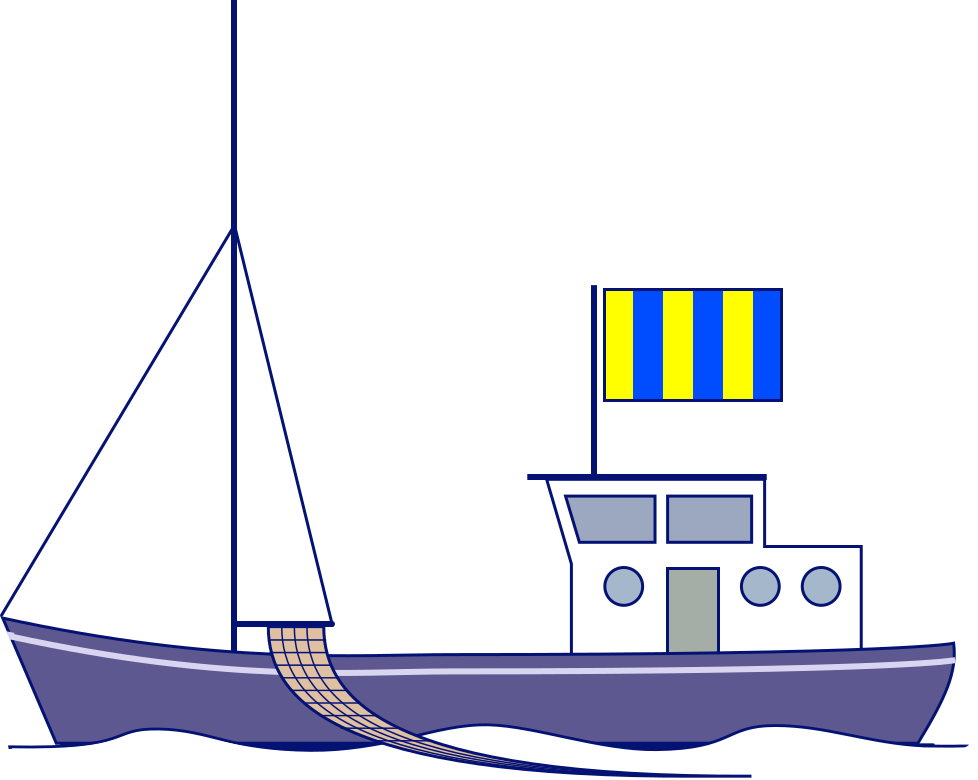
|
Day sign • Flag G | |
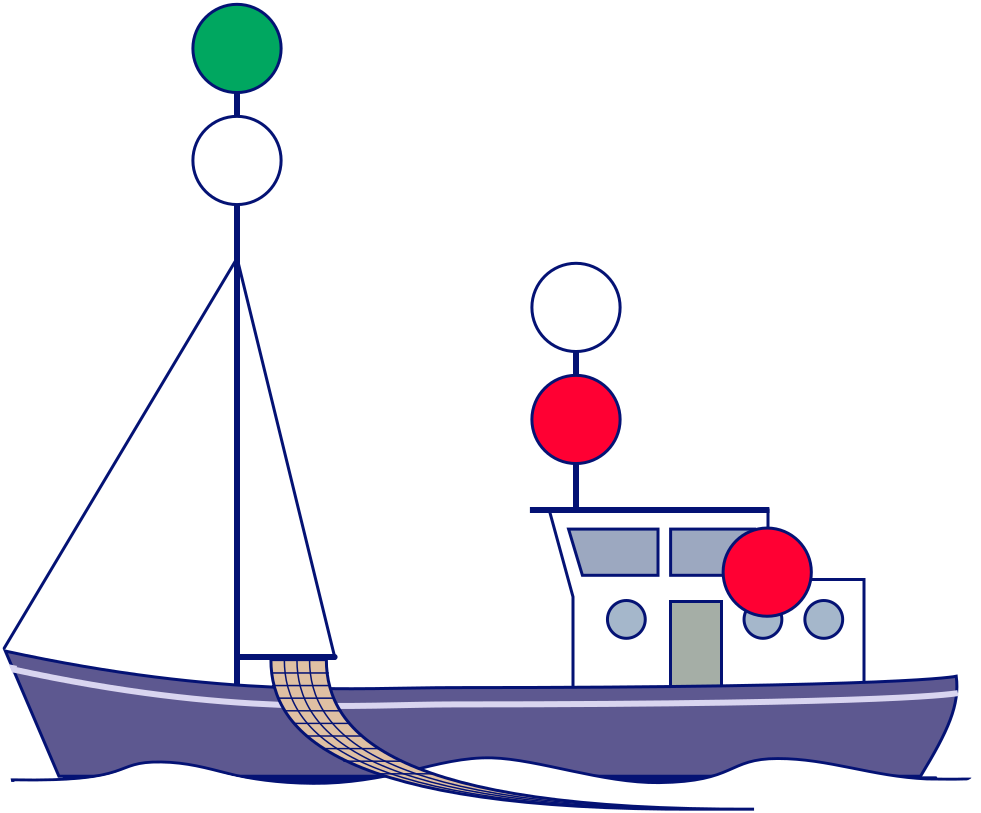
|
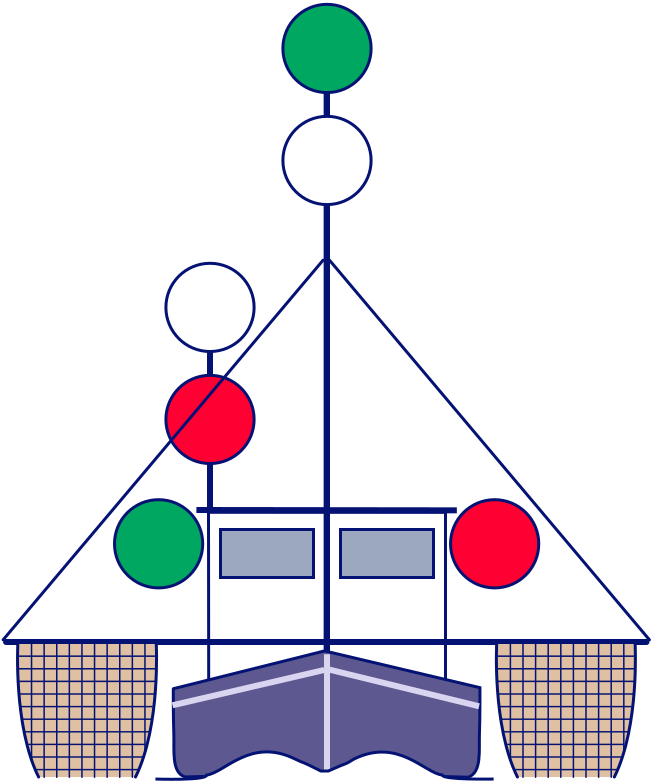
|
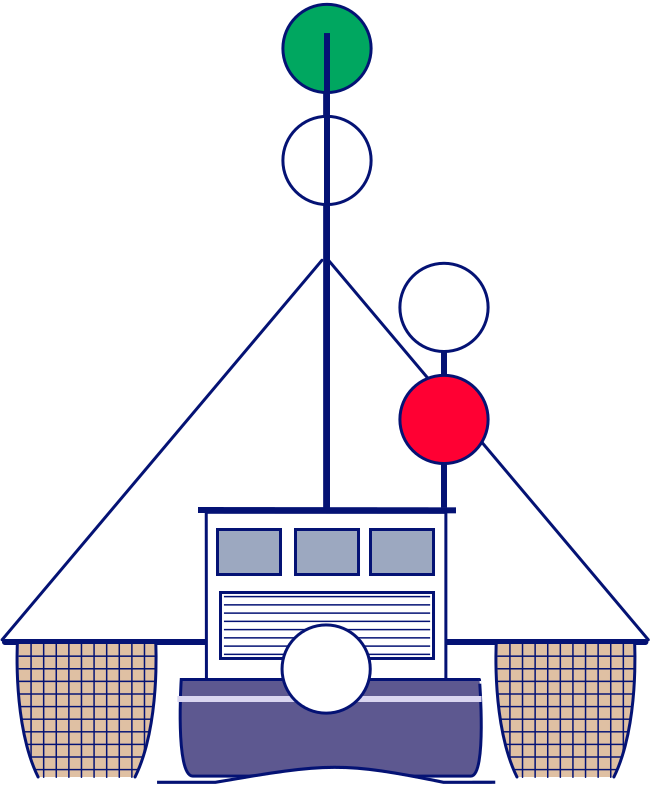
|
| Abeam, port side | Ahead | Astern |
| Fishing vessel, trawling, nets caught on bottom (red over red) | ||
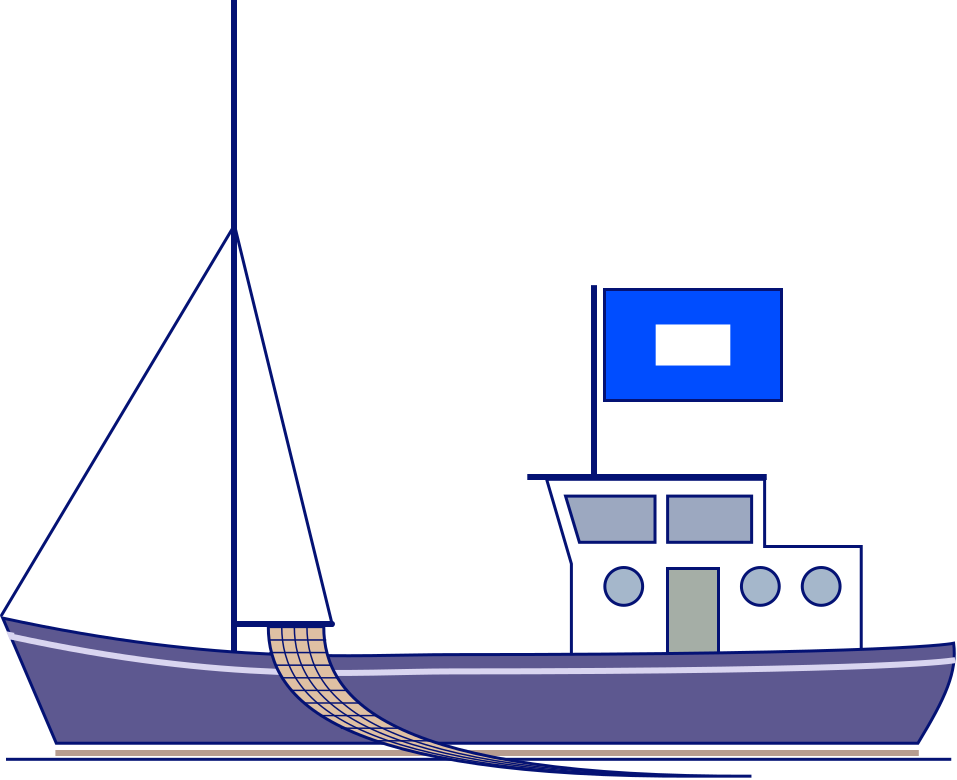
|
Day sign • Flag P | |
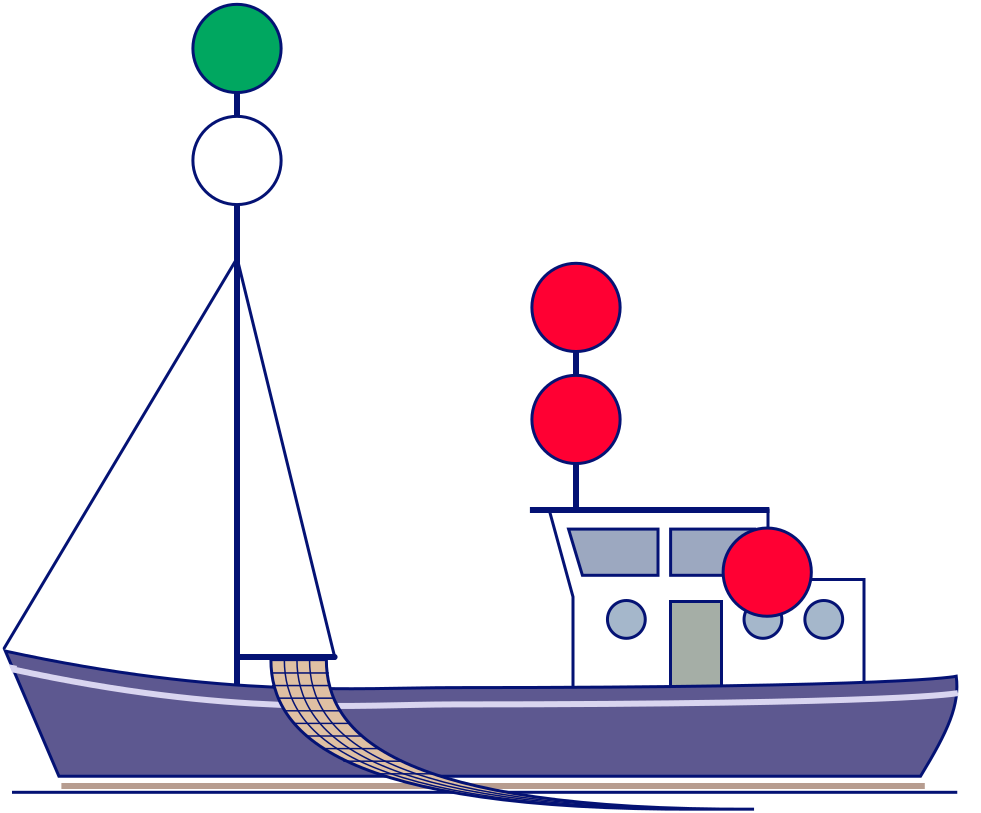
|
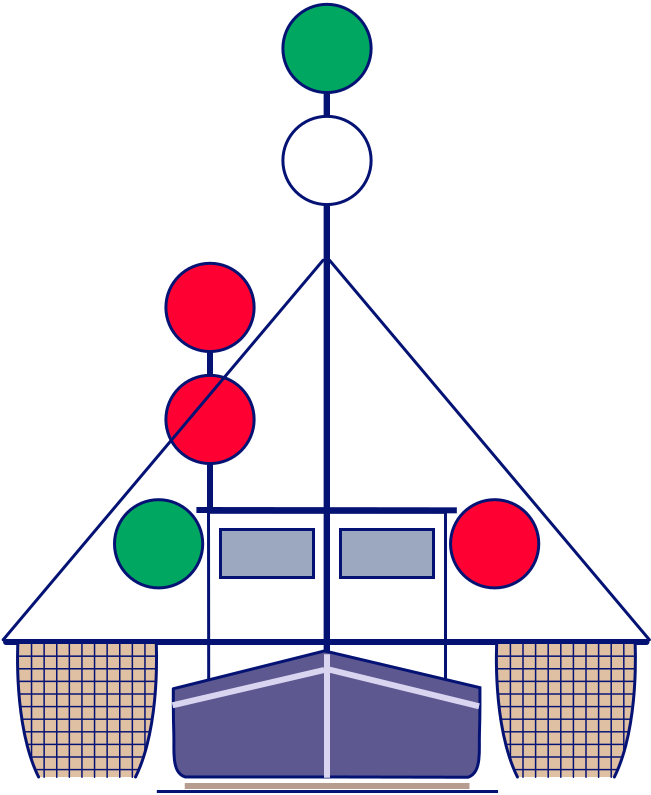
|
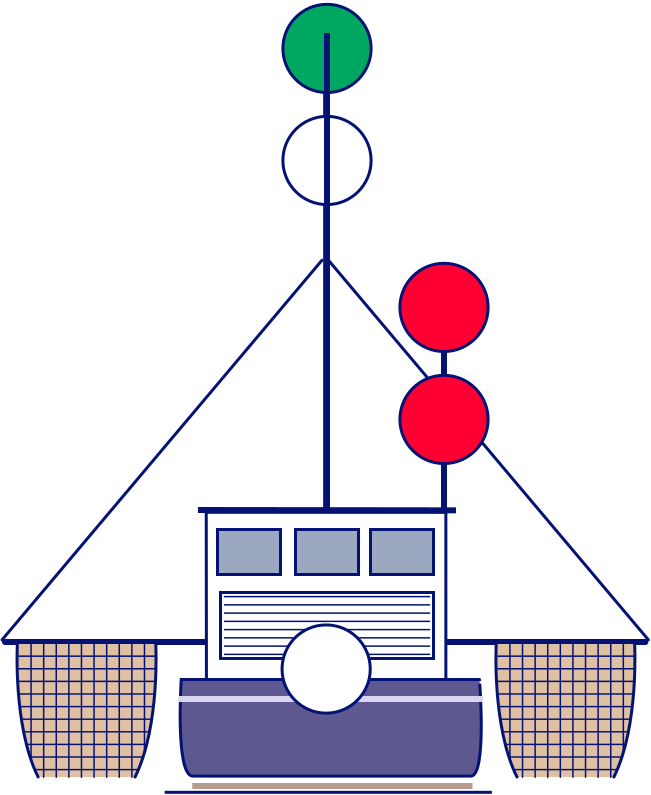
|
| Abeam, port side | Ahead | Astern |
Trawling in span
When pair trawling, each vessel shows searchlights on water aiming forward (Flag T by day); Rule 26 (f) (b)ǂ(2)
| Trawling in span, shooting nets | |
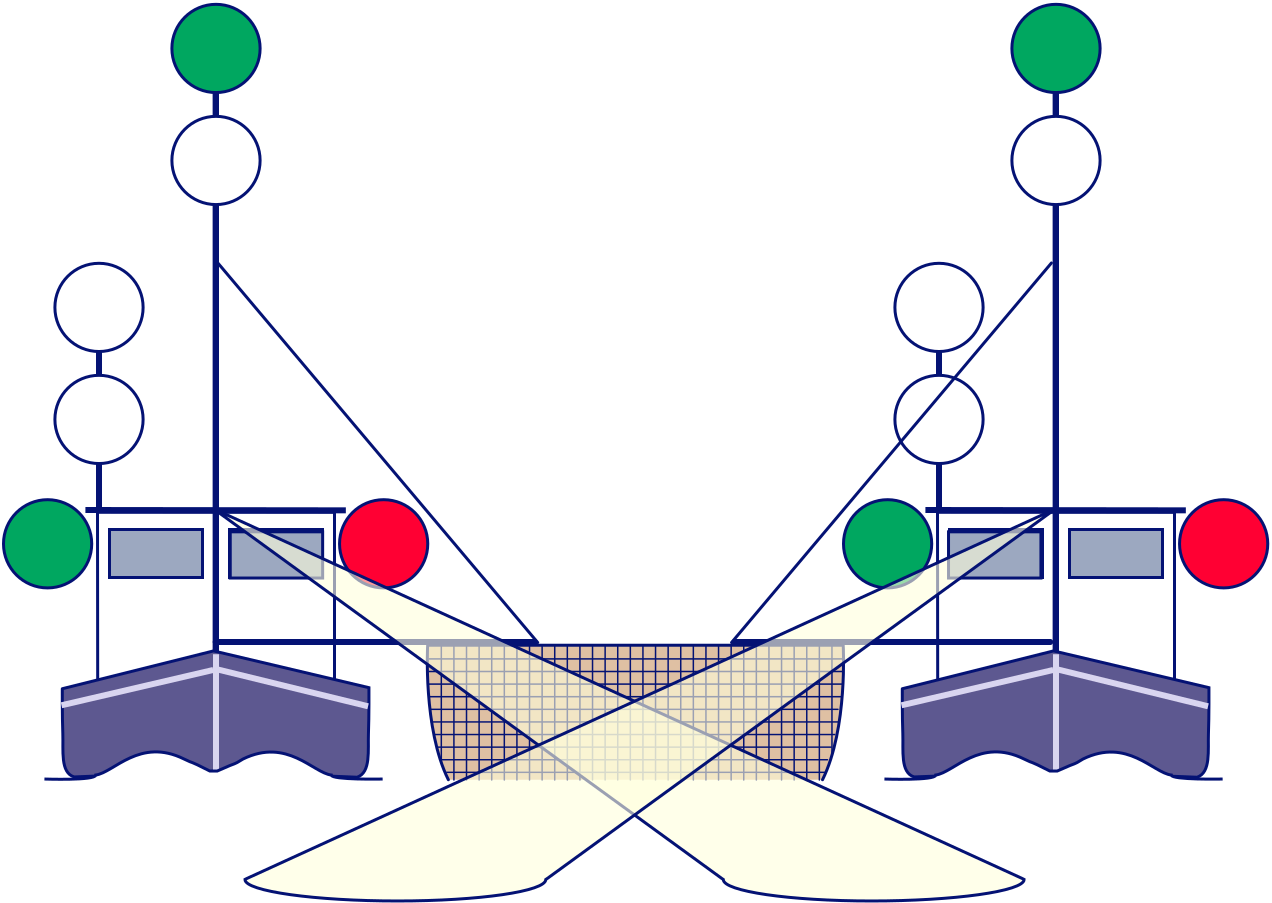
|
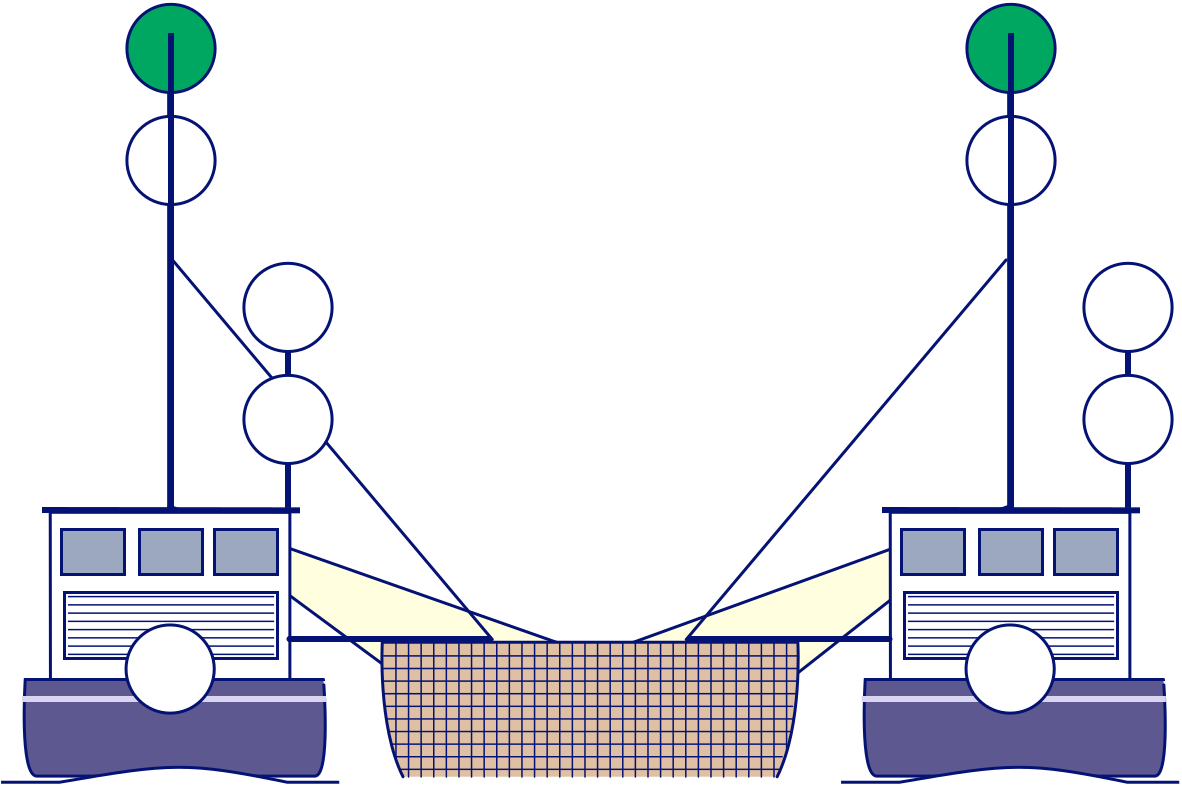
|
| Ahead | Astern |
Fishing, other than trawling
A vessel engaged in fishing, other than trawling, according to Rule 26 (c) shall exhibit:
- two all-round lights in a vertical line, the upper being red and the lower white, or a shape consisting of two cones with apexes together in a vertical line one above the other;
- when there is outlying gear extending more than 150 metres horizontally from the vessel, an all-round white light or a cone apex upwards in the direction of the gear;
- when making way through the water, in addition to the lights prescribed here, sidelights and a sternlight.
| Fishing vessel, other than trawling, outlying gear >150 m | ||
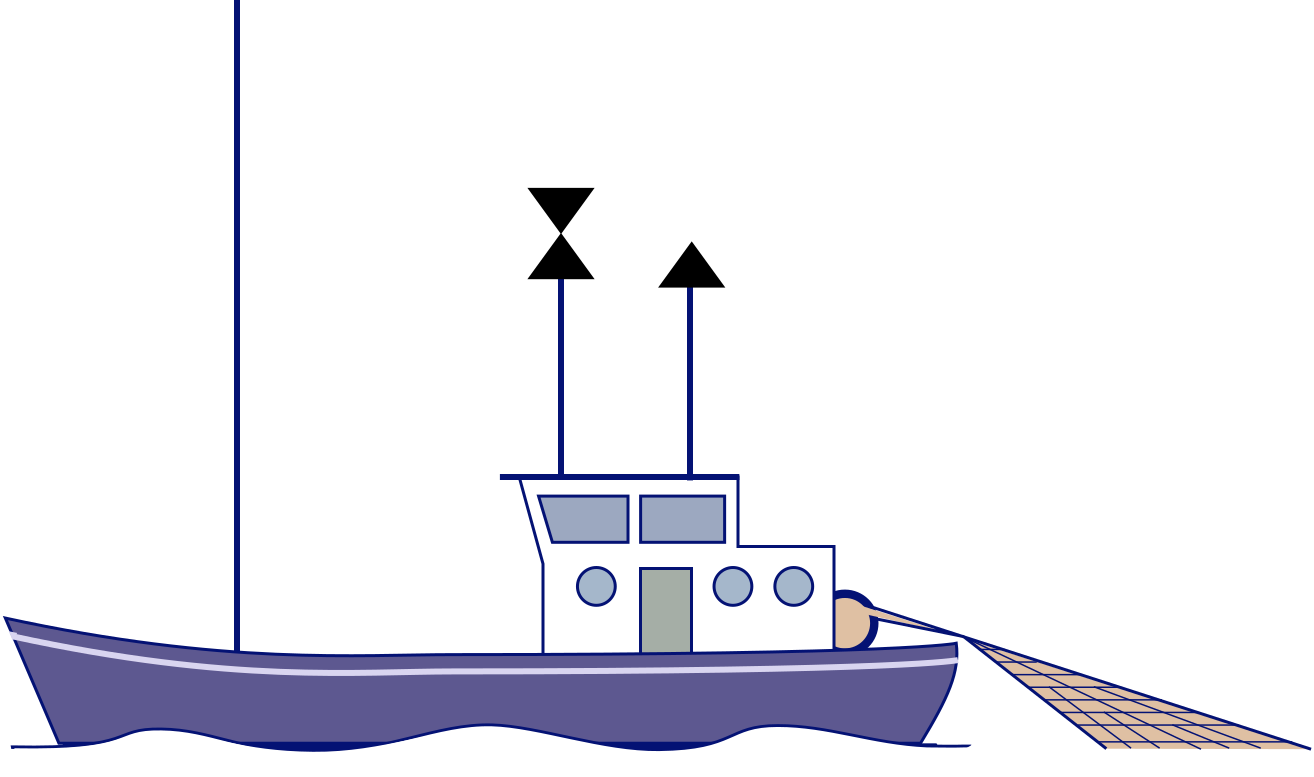
|
Day sign | |
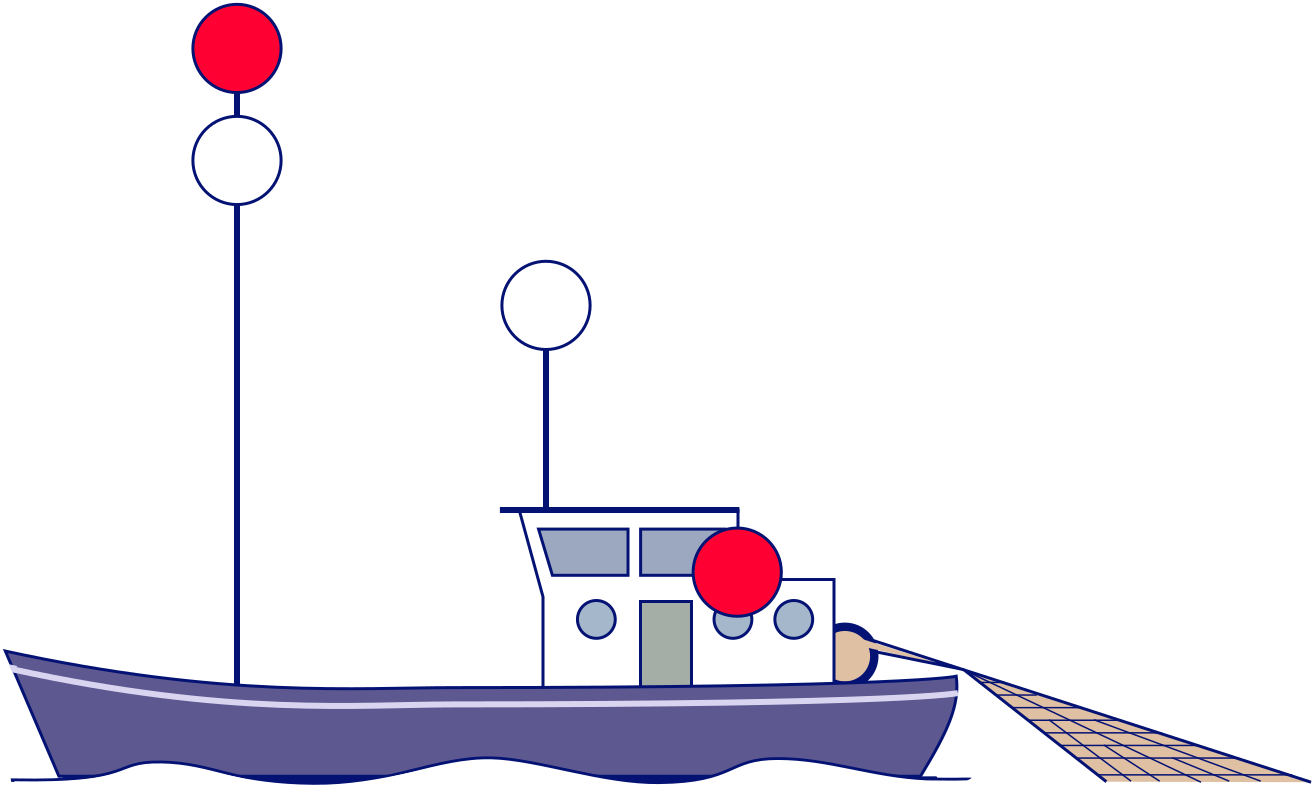
|
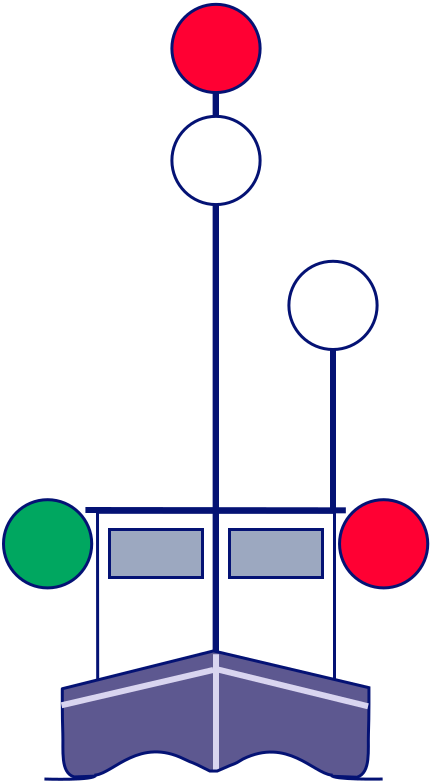
|
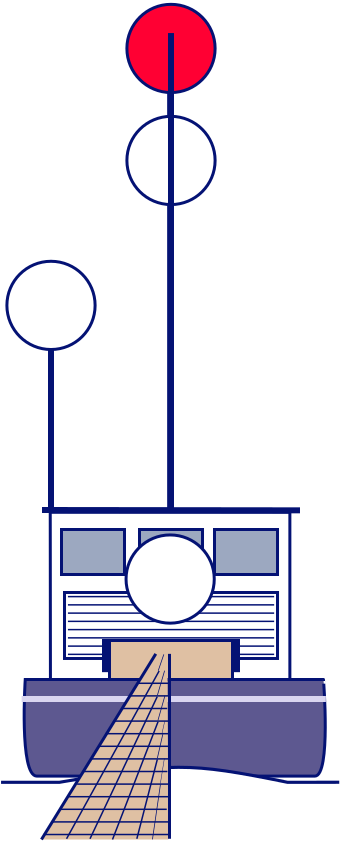
|
| Abeam, port side | Ahead | Astern |
See Fishing – Trawling section above.
Purse seining
Purse Seiners will exhibit two all-round yellow lights in a vertical line, flashing alternately; Rule 26 (f) 3ǂ(iii)
| Purse seiner fishing vessel | ||
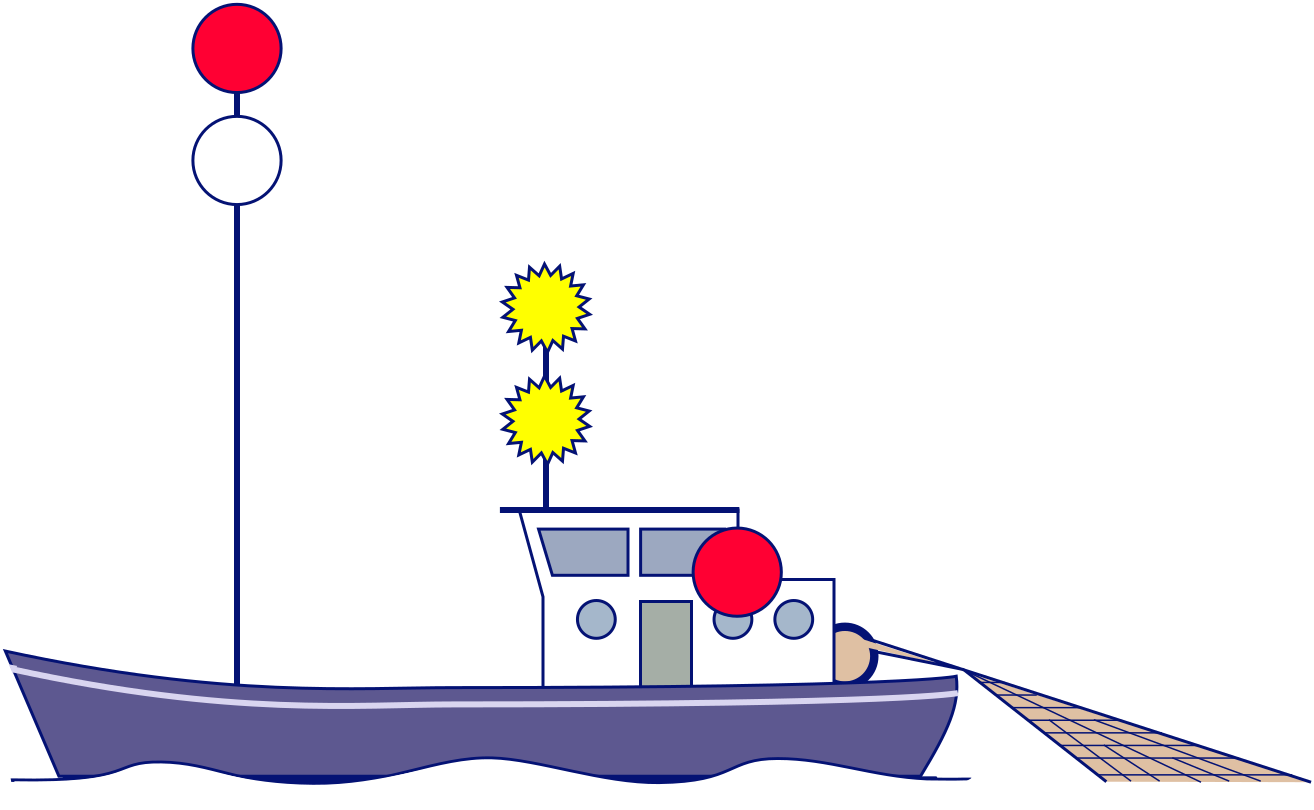
|
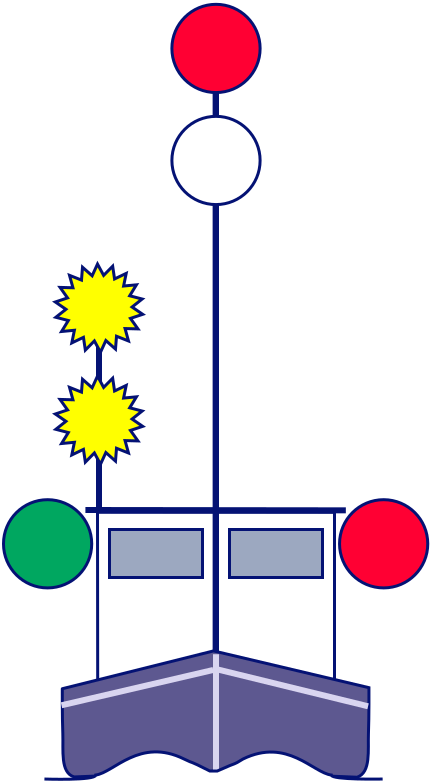
|
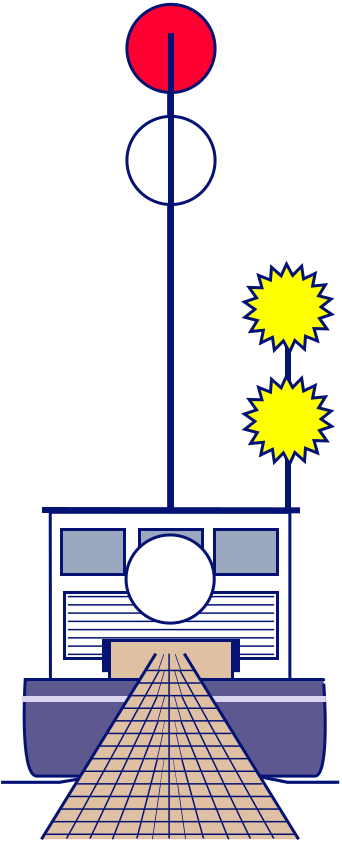
|
| Abeam, port side | Ahead | Astern |
Constrained by draught
A vessel constrained by her draught / draft may, (and not “shall”!) in addition to the lights prescribed for power-driven vessels, exhibit where they can best be seen three all-round red lights in a vertical line, or as day sign a cylinder, Rule 28
| Power driven vessel, underway, constrained by her draught | ||
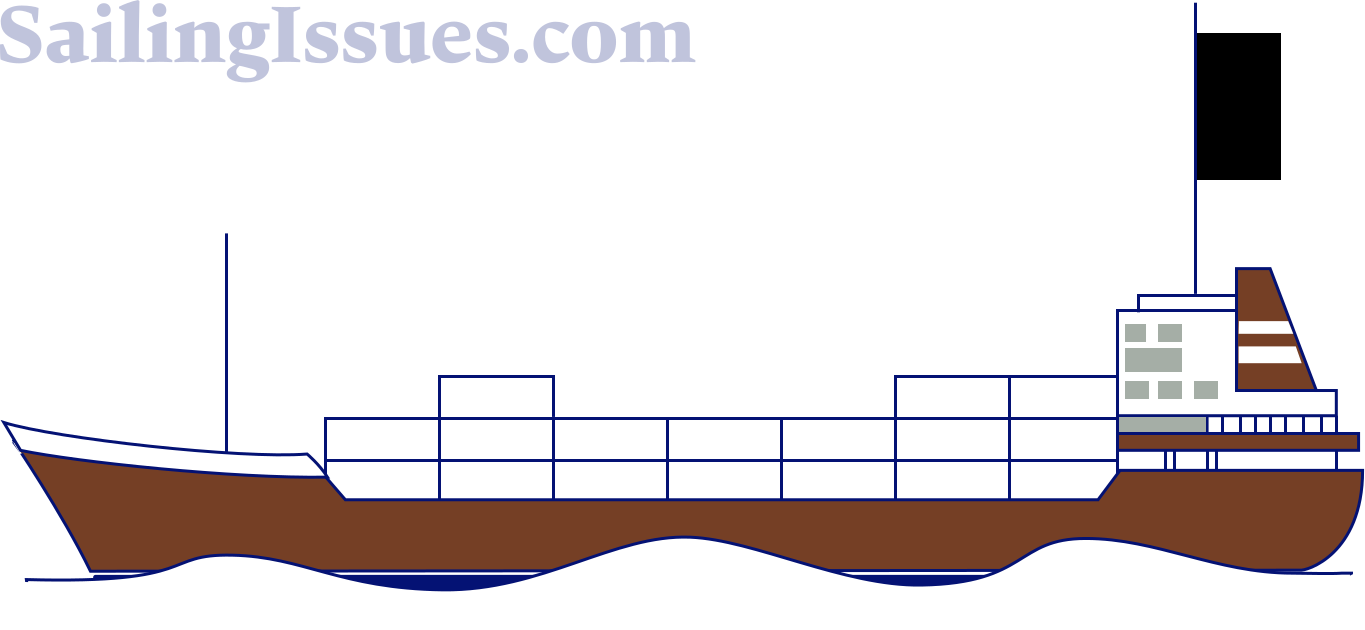
|
Day sign (black vertical cylinder) | |
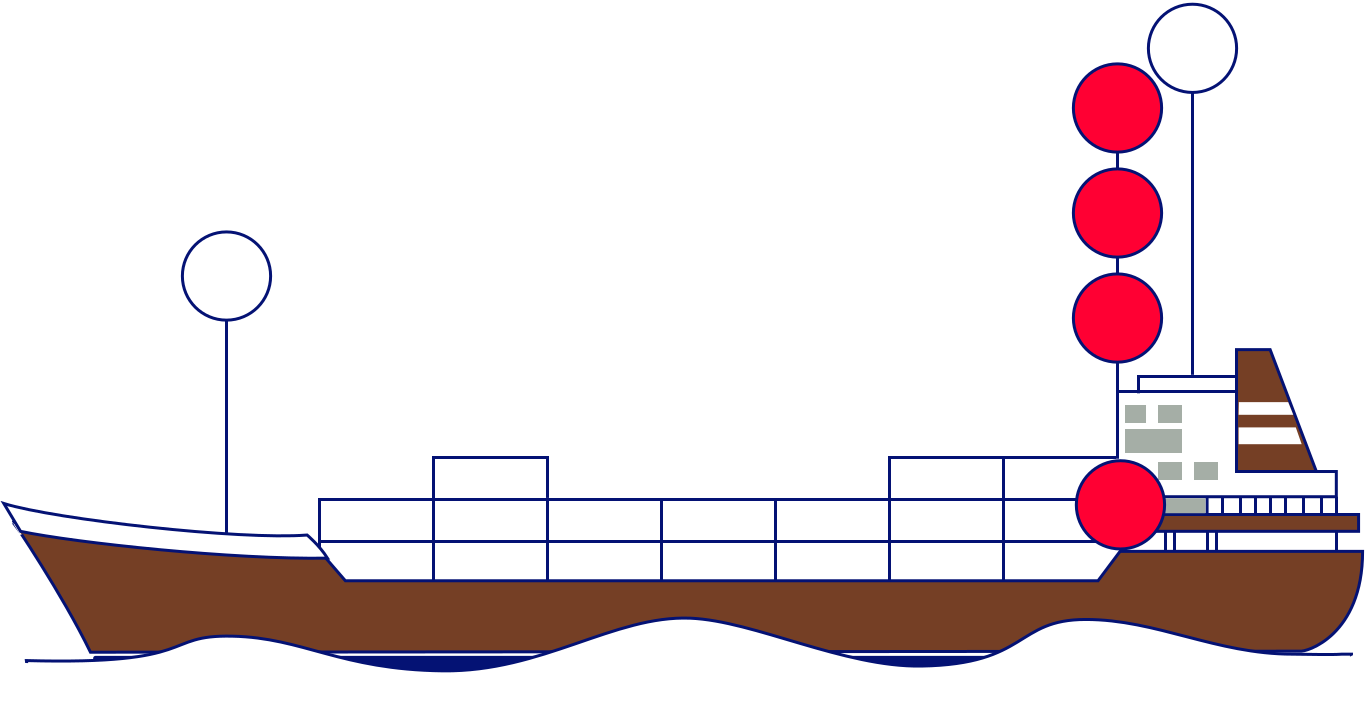
|
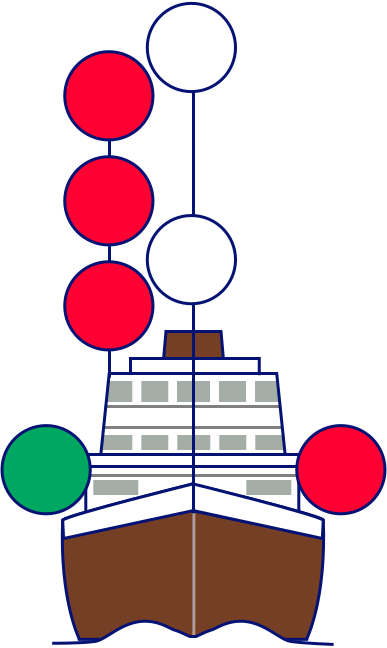
|
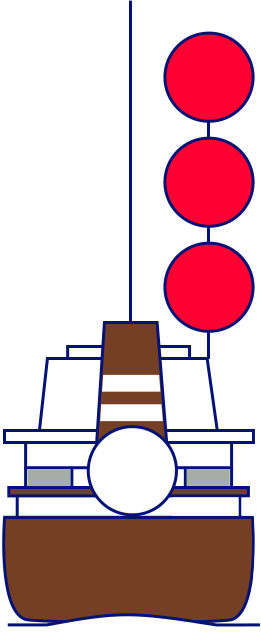
|
| Abeam, port side | Ahead | Astern |
Not under command
A vessel not under command, sometimes knows as a NUC vessel, shall according to Rule 27(a) exhibit:
- two all-round red lights in a vertical line where they can best be seen;
- two spherical shapes in a vertical line where they can best be seen; and
- when making way through the water also normal sidelights and a sternlight (not shown in the examples below).
| Vessel not under command, not making way through the water | ||
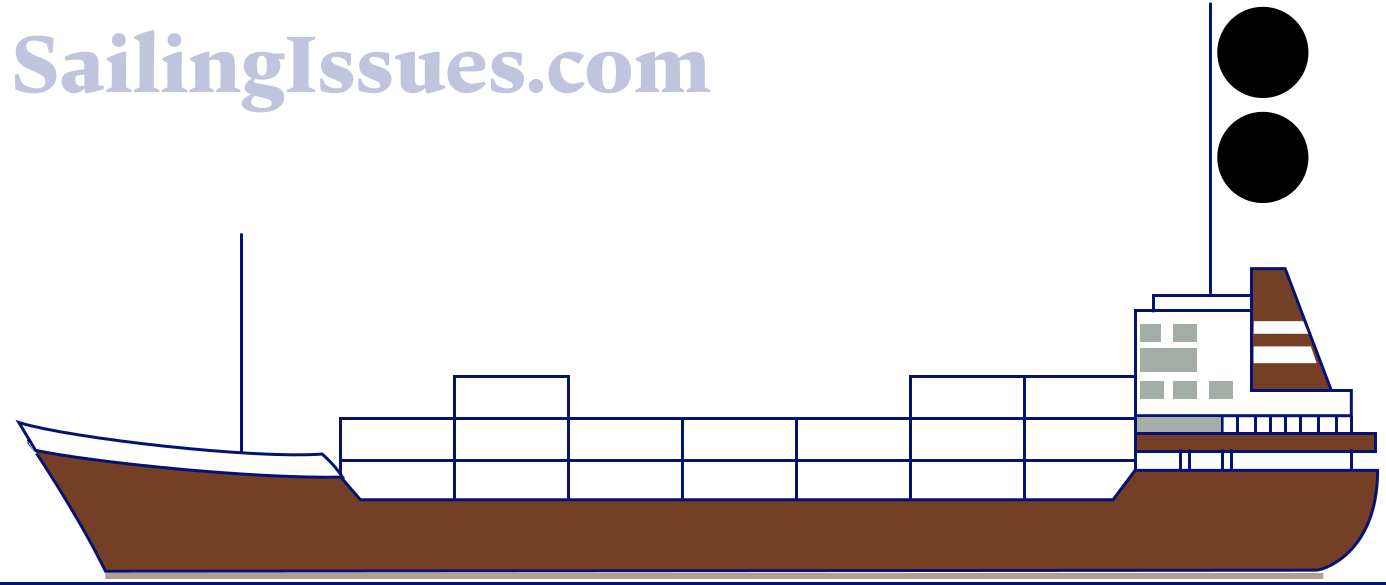
|
Day sign (two black spheres) | |
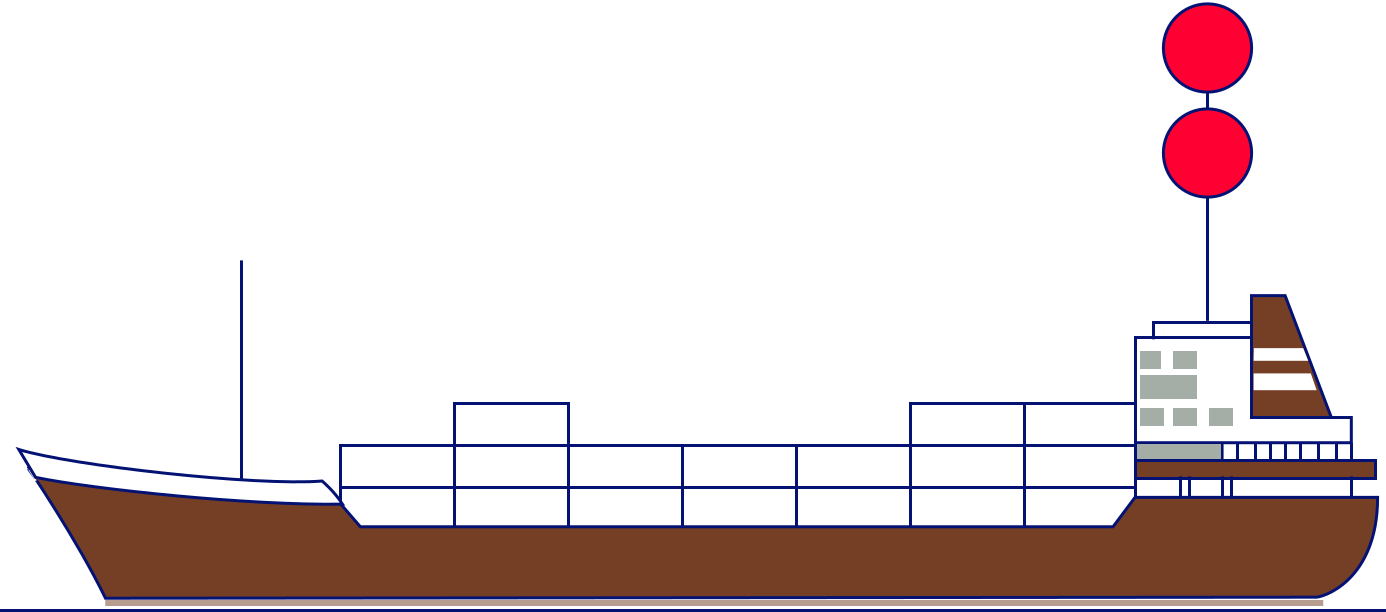
|
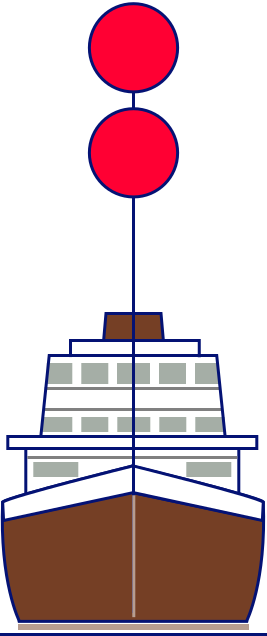
|
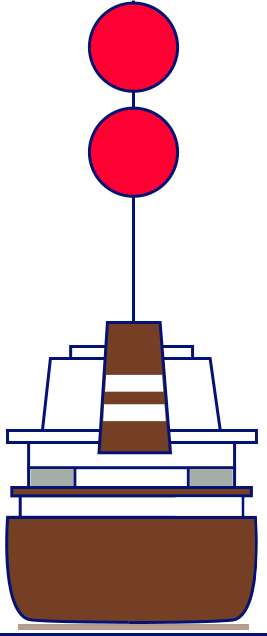
|
| Abeam, port side | Ahead | Astern |
| Sailing boat, no wind, no mechanical propulsion | ||
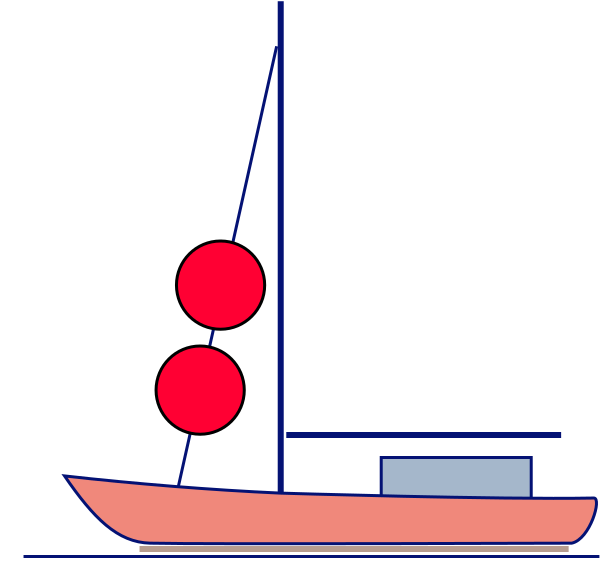
|
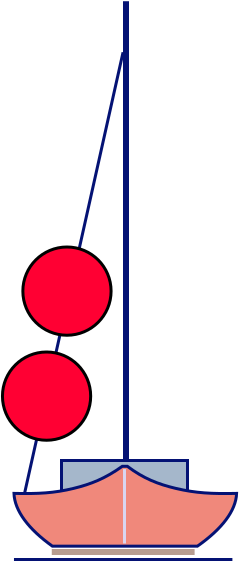
|
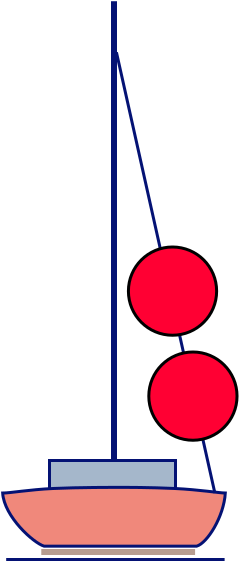
|
| Abeam, port side | Ahead | Astern |
Restricted in her ability to manoeuvre
A vessel restricted in her ability to manoeuvre, sometimes knows as a RAM vessel, except a vessel engaged in mine clearance operations, shall according to Rule 27(b) exhibit:
- three all-round lights in a vertical line where they can best be seen. The highest and lowest of these lights shall be red and the middle light shall be white;
- three shapes in a vertical line where they can best be seen. The highest and lowest of these shapes shall be balls and the middle one a diamond;
- when making way through the water, also a masthead light or lights, sidelights and a sternlight
| Restricted in her ability to manoeuvre, not making way through the water | ||
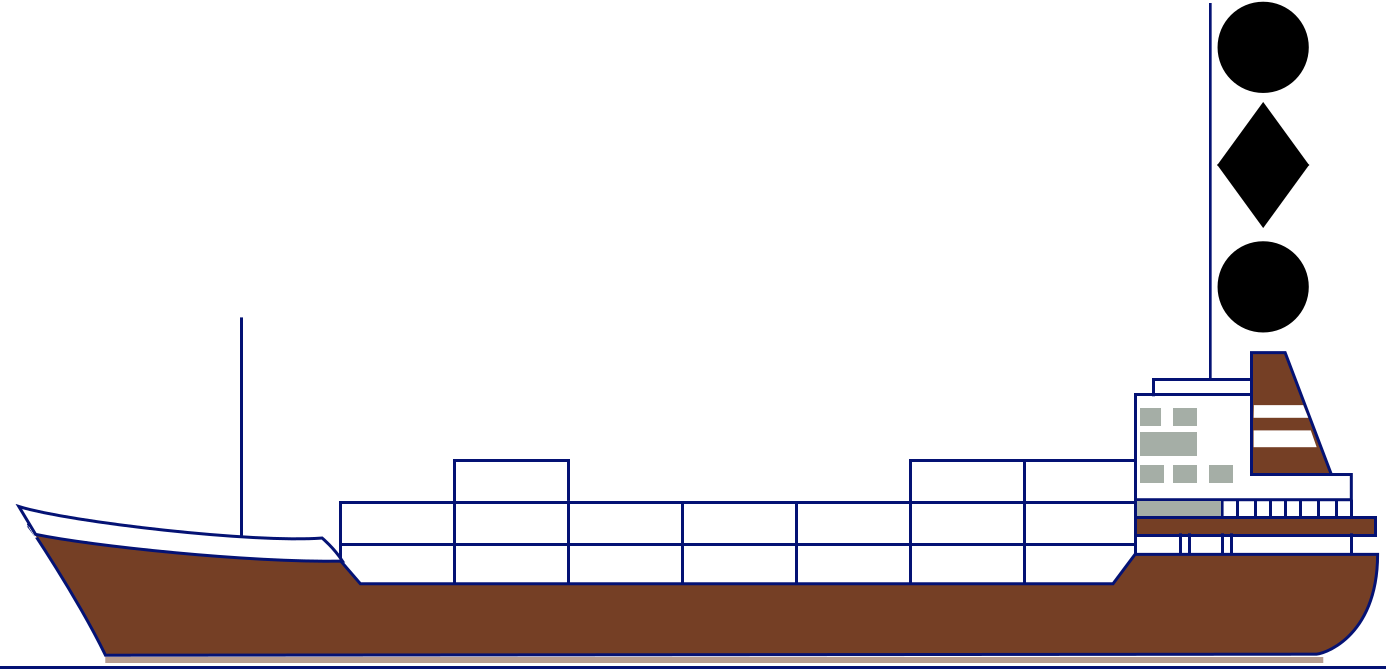
|
Day sign: two black spheres and in the middle a black diamond shape | |
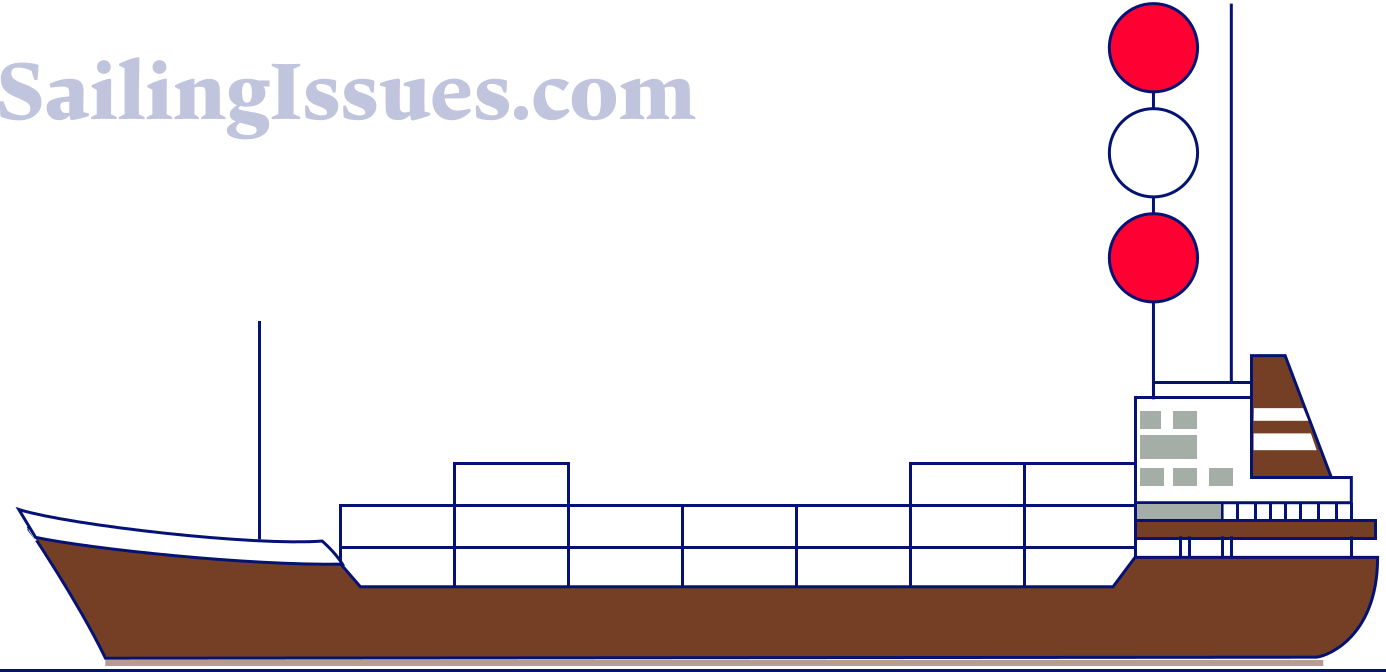
|
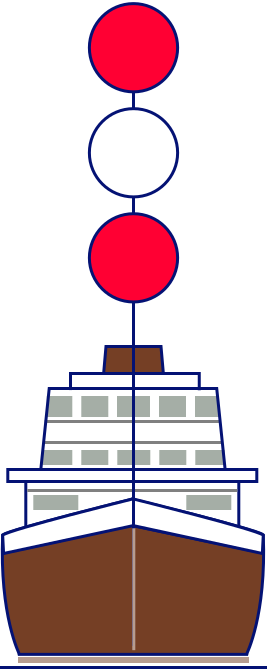
|
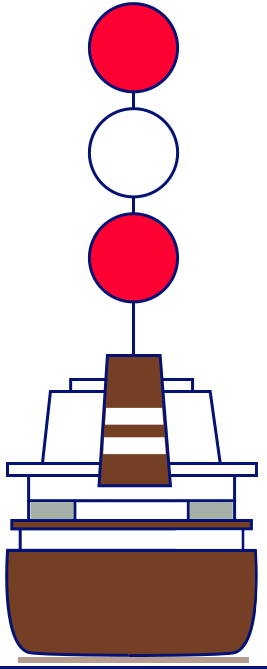
|
| Abeam, port side | Ahead | Astern |
| Restricted in her ability to manoeuvre, making way through the water, longer than 50 m | ||
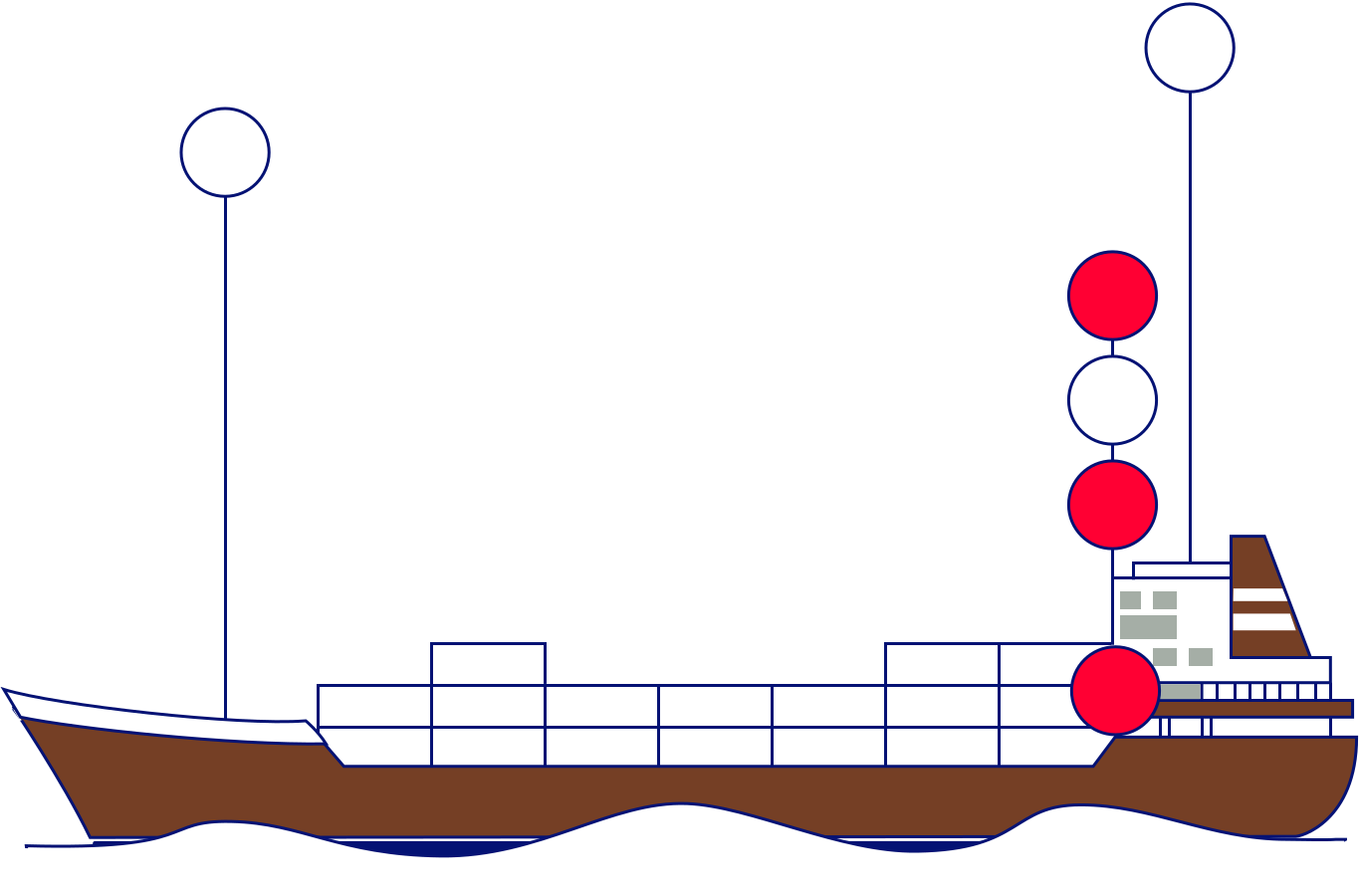
|
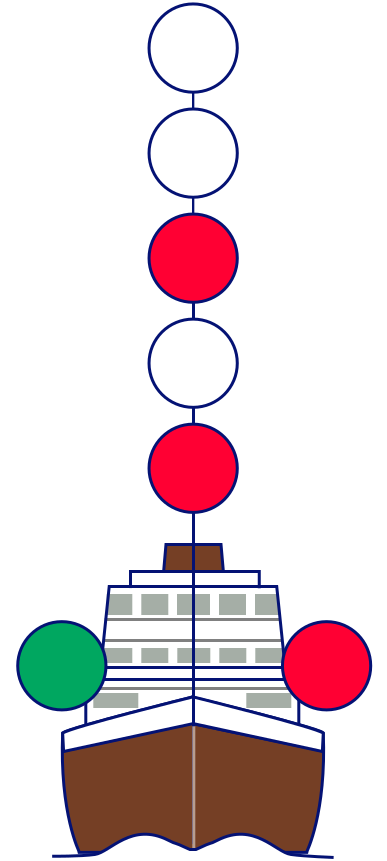
|
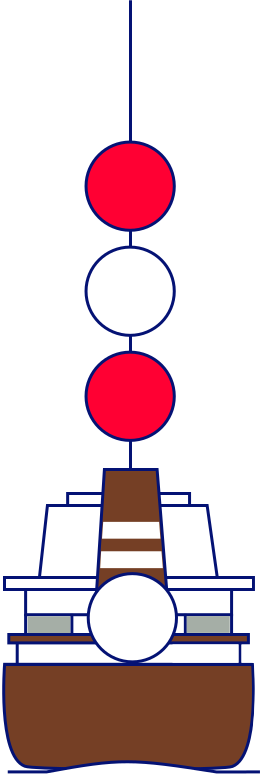
|
| Abeam, port side | Ahead | Astern |
Dredging or underwater operations
A vessel engaged in dredging or underwater operations, when restricted in her ability to manoeuvre; Rule 27(d), shall exibit
- two all-round red lights or two balls in a vertical line to indicate the side on which the obstruction exists;
- two all-round green lights or two diamonds in a vertical line to indicate the side on which another vessel may pass; and
- when at anchor (or not making way), the lights or shapes prescribed in this section instead of the lights or shapes prescribed in Rule 30
| Dredging or underwater operations, shorter than 50 m, not making way | ||
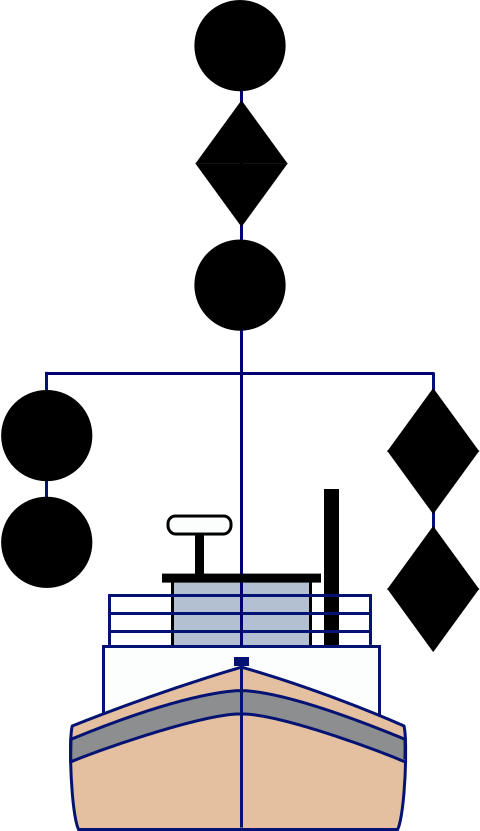
|
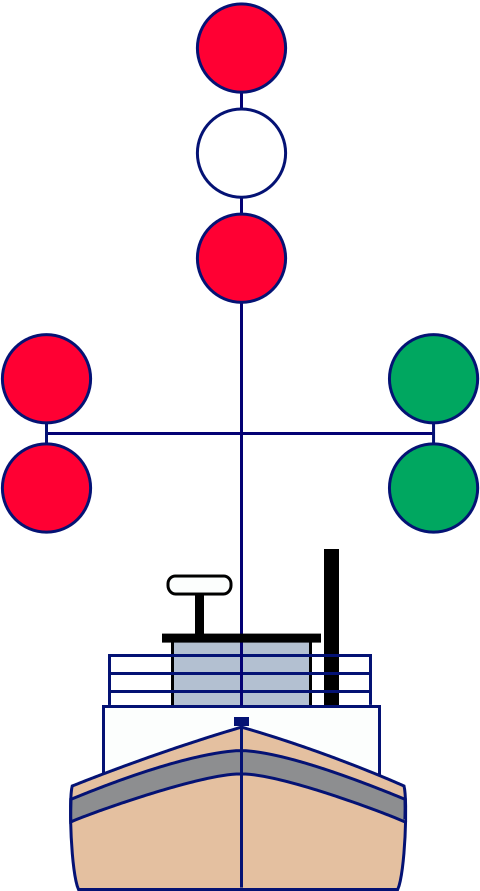
|
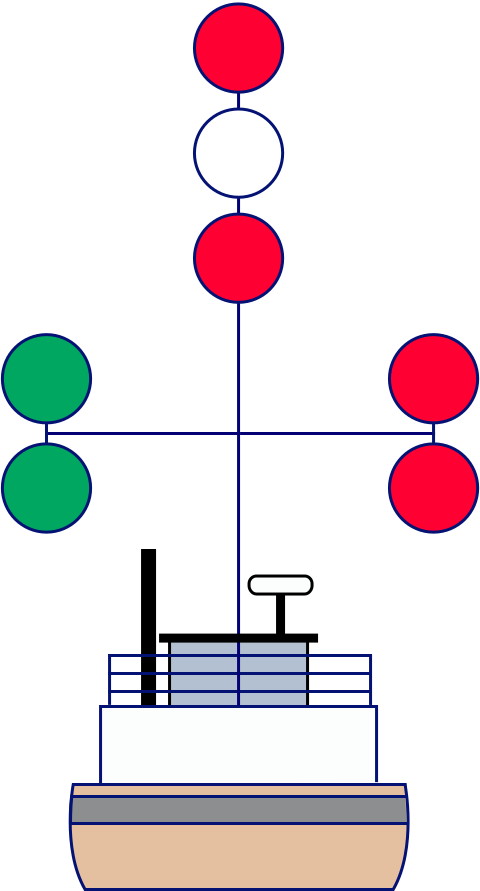
|
| Ahead, day signs | Ahead | Astern |
| Dredging or underwater operations, shorter than 50 m, making way | ||
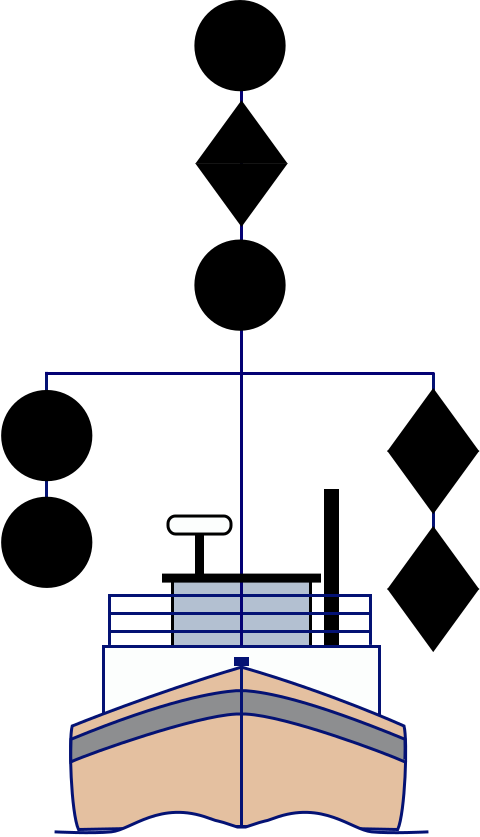
|
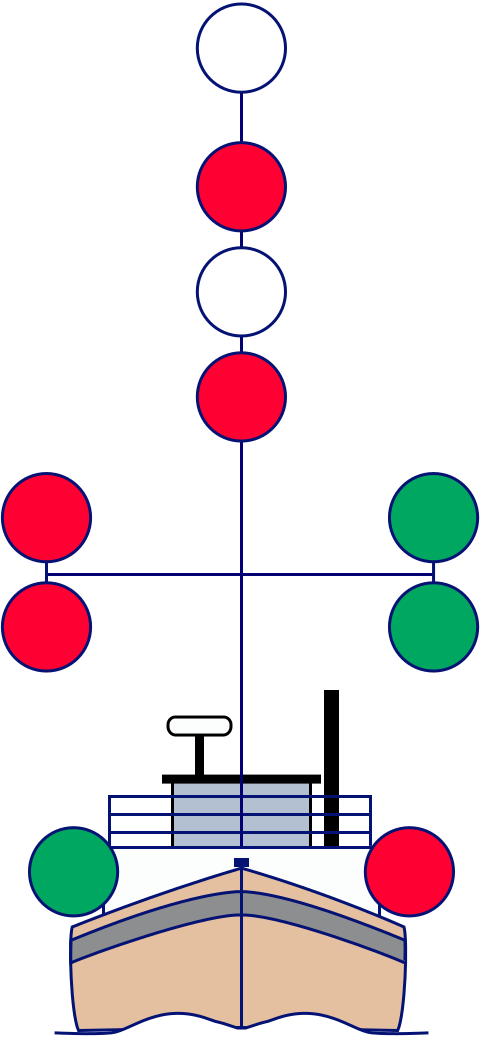
|
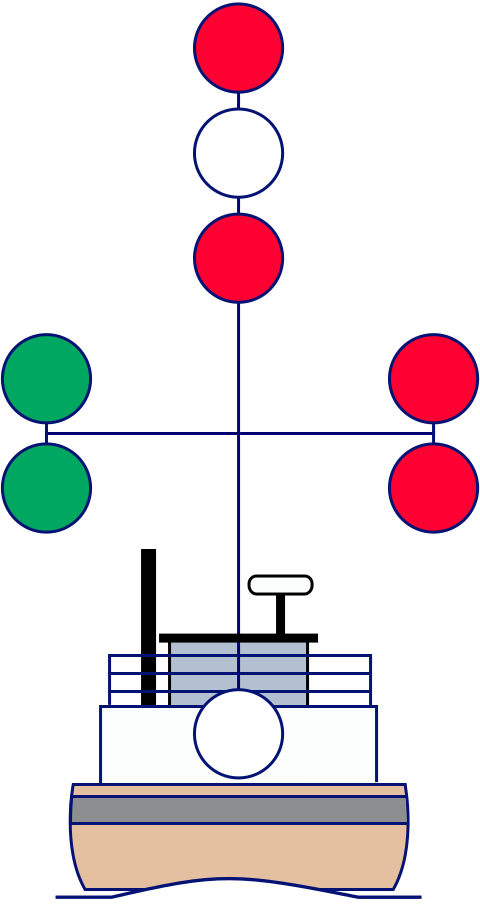
|
| Ahead, day signs | Ahead | Astern |
| Dredging or underwater operations, longer than 50 m, making way | ||

|
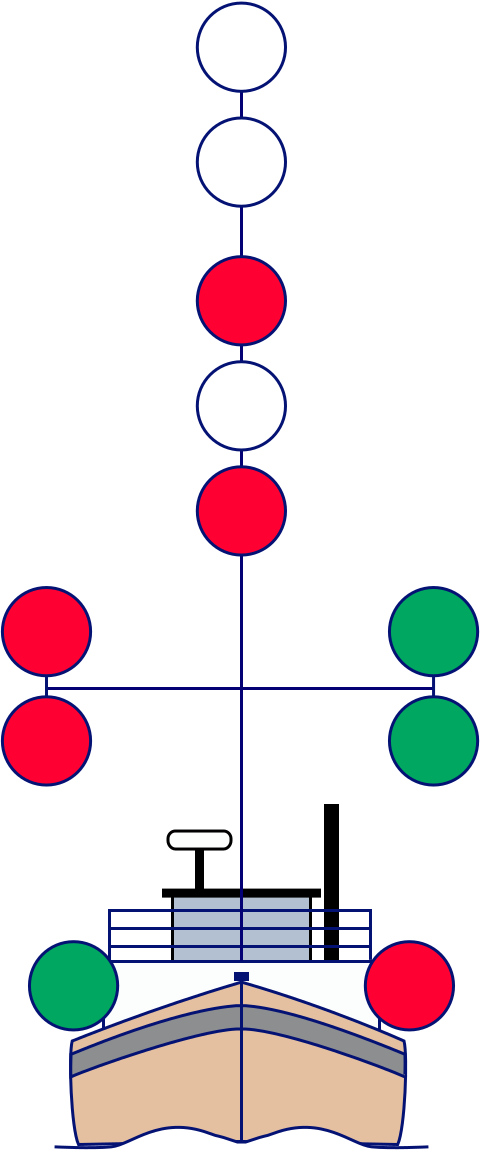
|

|
| Ahead, day signs | Ahead | Astern |
Small diving vessel
| Small diving vessel | ||
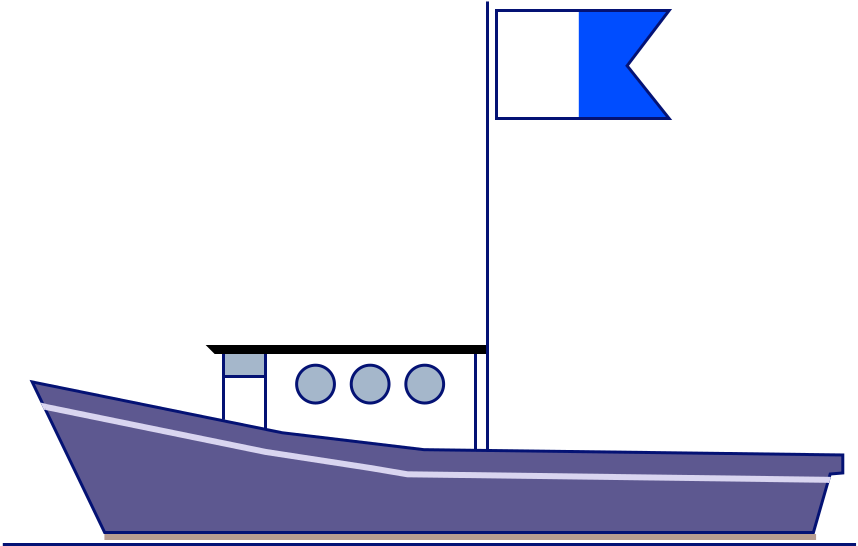
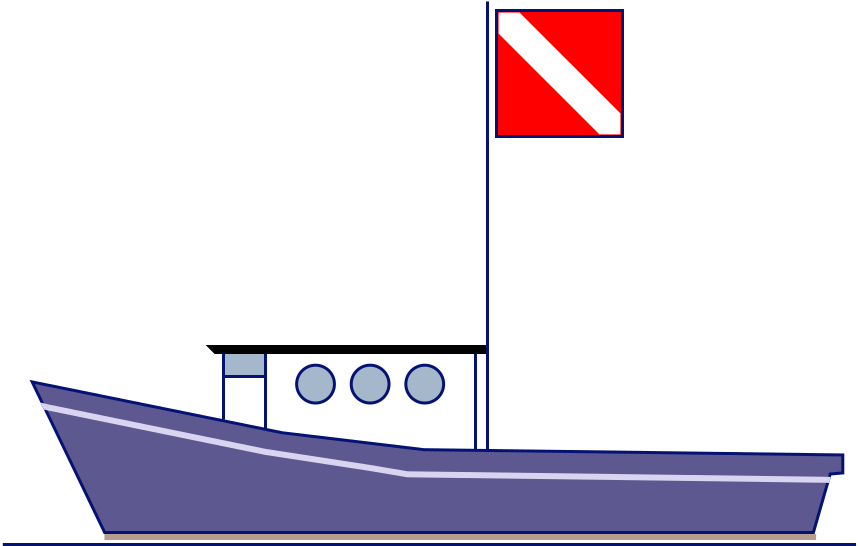
|
Day signs | |
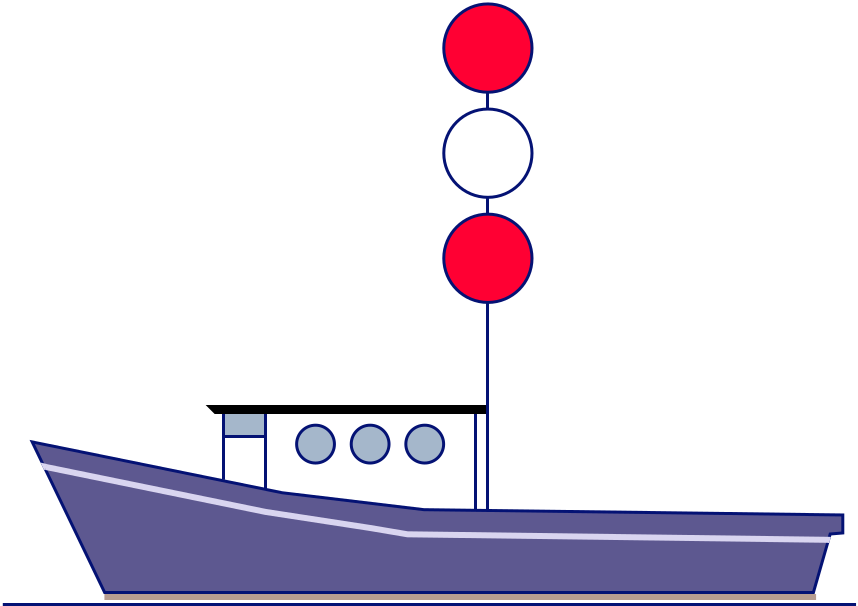
|
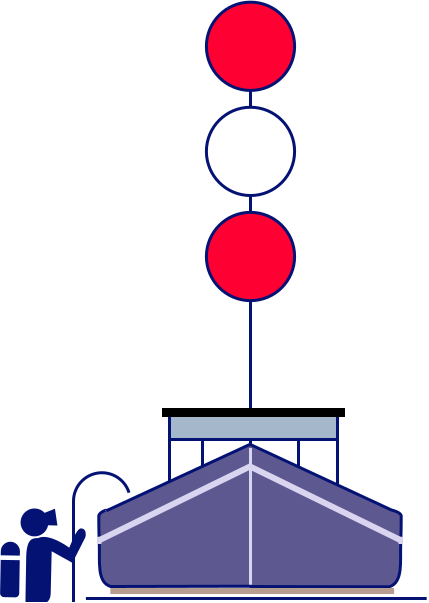
|
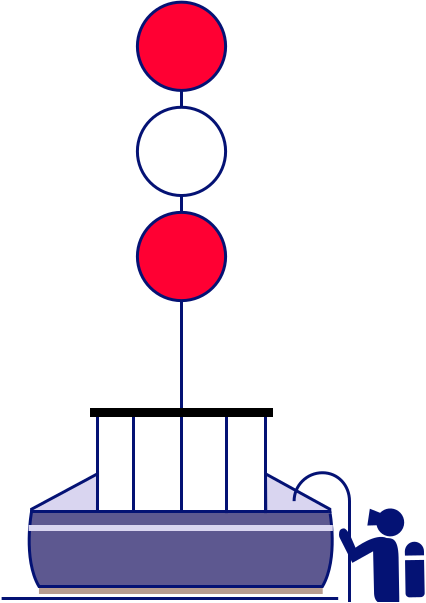
|
| Abeam, port side | Ahead | Astern |
Pilot boat
Rule 29, duty shall exhibit:
- at or near the masthead, two all-round lights in a vertical line, the upper being white and the lower red;
- when underway, in addition, sidelights and a sternlight; as shown in the example below.
| Pilot boat, shorter than 50 m | ||
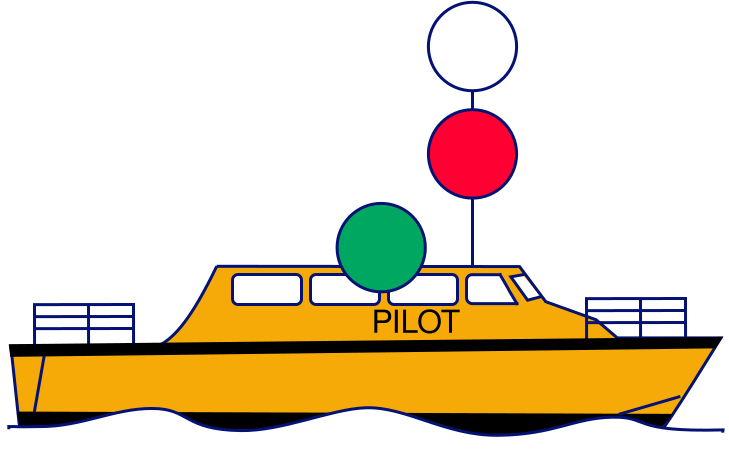
|
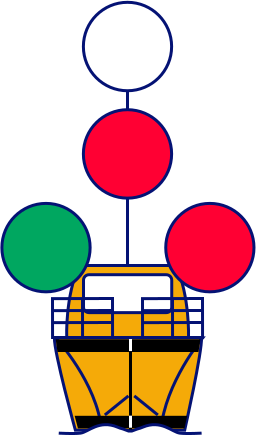
|
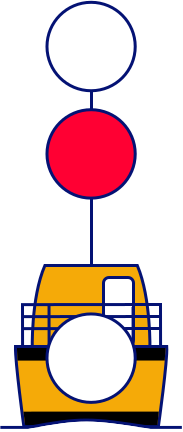
|
| Abeam, starboard side | Ahead | Astern |
Hovercraft, hydrofoil ferry
An air-cushion vessel when operating in non-displacement mode shall, besides a masthead light forward, (plus a masthead light abaft if longer than 50 m) sidelights and a sternlight, exhibit an all‑round flashing yellow light (faster than 2 flashes per second). Rule 23(b)
Also a hydrofoil ferry or high speed catamaran when acting as ferry is often allowed under local regulations to exhibit an all-round flashing yellow light.
| Hovercraft, longer than 50 m | ||
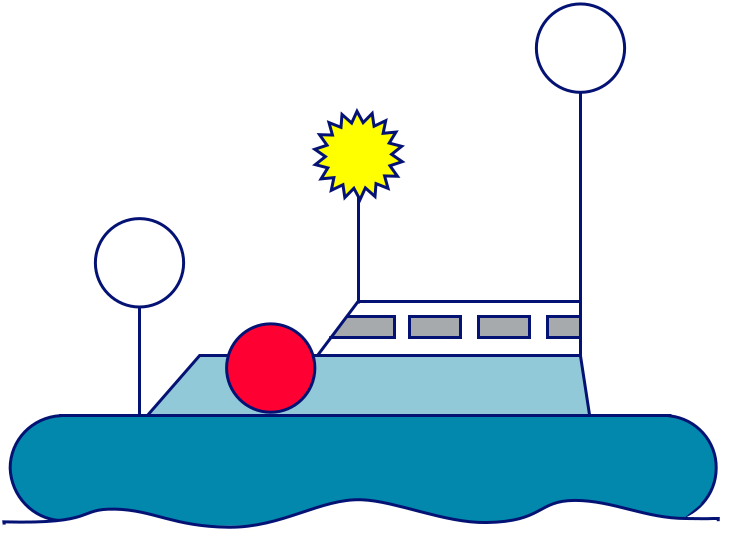
|
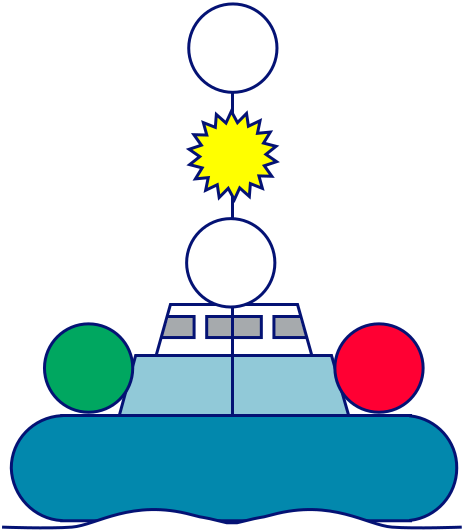
|
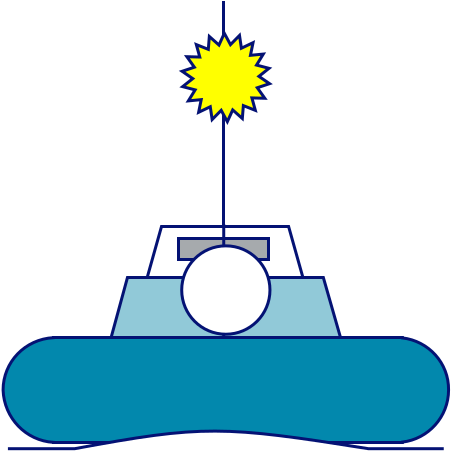
|
| Abeam, port side | Ahead | Astern |
High speed catamarans ferries and foiling ferries may also exhibit the flashing yellow light.
Minesweeper
A vessel engaged in mine clearance operations shall in addition to the lights prescribed for a power-driven vessel, or to the lights or shape prescribed for a vessel at anchor, exhibit three all-round green lights or three balls. One of these lights or shapes shall be exhibited near the mast head and one at each end of the fore yard. These lights or shapes indicate that it is dangerous for another vessel to approach within 1000 metres of the mine clearance vessel. Rule 27(f)
| Minesweeper, shorter than 50 m, making way | ||
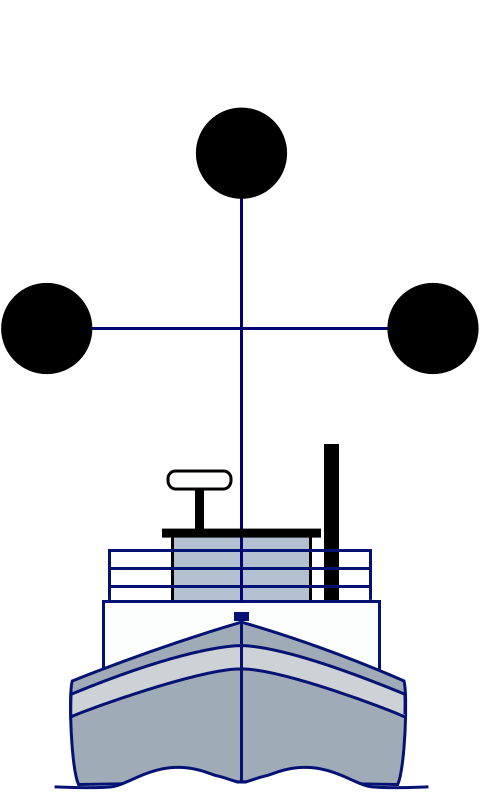
|
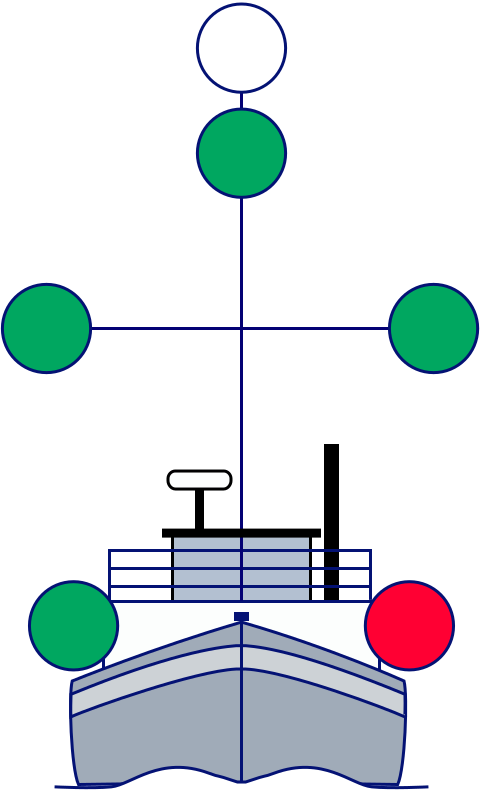
|
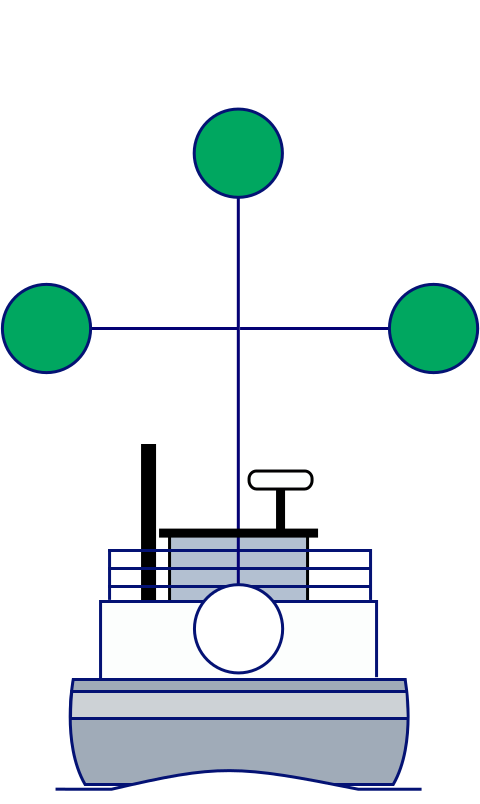
|
| Ahead, day signs (3 black spheres) | Ahead | Astern |
Overview
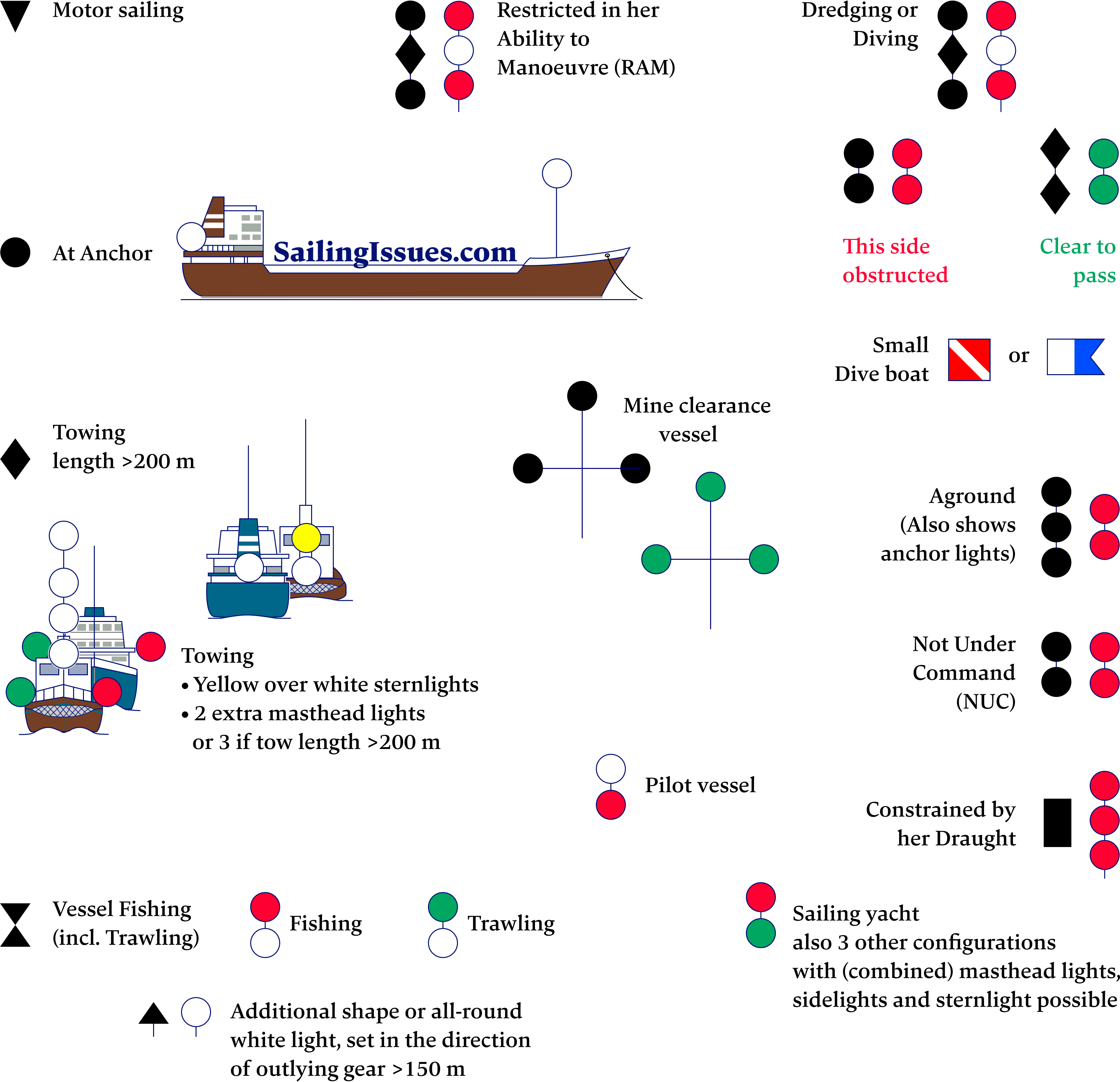
Lights are all-round except where indicated. |
- Course overview: goals and introduction
- Positions: latitude, longitude, nautical mile, scale, knots
- Nautical chart: coordinates, positions, courses, chart symbols, projections
- Compass: variation, deviation, true • magnetic • compass courses
- Plotting and piloting: LOPs, (running) fix, dead reckoning, leeway, CTS, CTW, COG
- Advanced piloting: double angle on the bow • four point • special angle fix, distance of horizon, dipping range, vertical sextant angle, radians, estimation of distances
- Astronomical origin of tides: diurnal, semi-diurnal, sysygy, spring, neap, axial tilt Earth, apsidal • nodal precession, declination Moon and Sun, elliptical orbits, lunar nodes
- Tides: tidal height prediction, chart datums, tidal curves, secondary ports
- Tidal streams and currents: diamonds, Course to Steer, Estimated Position
- Aids to navigation: buoys, leading lights, ranges, characteristics, visibility
- Lights and shapes: vessels sailing, anchoring, towing, fishing, NUC, RAM, dredging
Also you can download the exercises + answers PDF ![]()